Every year, IndieWire reaches out to the cinematographers behind the films premiering at the 2023 Sundance Film Festival, and asks which cameras, lenses, and formats they used, and why they chose them to create the looks and meet the production demands of their films. Here are the responses from filmmakers who brought scripted narrative features to the festival; check back tomorrow for a survey of the 2023 documentary lineup.
Films appear in alphabetical order by title.

Behind the scenes of “The Accidental Getaway Driver”
Courtesy of Filmmaker
Dir: Sing J. Lee, DoP: Michael Cambio Fernandez
Format: 3.2K Arriraw
Camera: Arri Alexa Mini
Lens: Hawk Anamorphic
Fernandez: I think the wide aspect ratio helped tell the story of four characters in small spaces and emphasize the feelings of being trapped. The Mini helped us get into limited spaces and using one camera allowed the characters to move with what limited spaces we had. The story is about three escaped convicts and one taxi driver held hostage, so the feeling of being limited needed to come across. We wanted to the audience to feel trapped in with our hostage.
Dir: Raven Jackson, DoP: Jomo Fray
Format: 35mm
Camera: Arri Arricam LT
Lens: Arri Master Primes
Fray: We wanted to create an image that was deeply tactile and elemental in its design. Before I even read the script the director, Raven Jackson, told me she was dreaming of this film in 35mm. In a way, shooting on film for us embodied a holistic approach to the work. It gave us the tactile feel and texture we were looking for, but also forced us to have a certain level of intention with each image we created. We crafted an artistic manifesto for the film that we read at the start of each day together. We wanted the light and camera to feel naturalistic and paired down to its most elemental component parts — and we wanted our tools to reflect those values. Shooting on the Arricam LT with the Master Primes gave us the ability to be nimble and quickly adapt to changing conditions. I love the way the Master Primes render on film. They have a soft naturalism that immediately drew us both in.
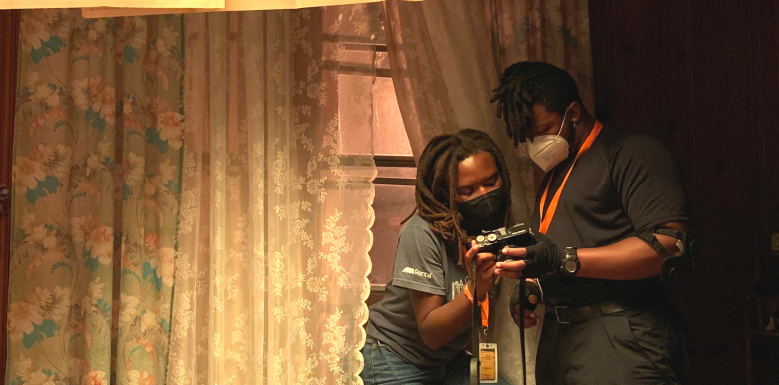
Behind the scenes of “All Dirt Roads Taste of Salt”
Courtesy of Filmmaker
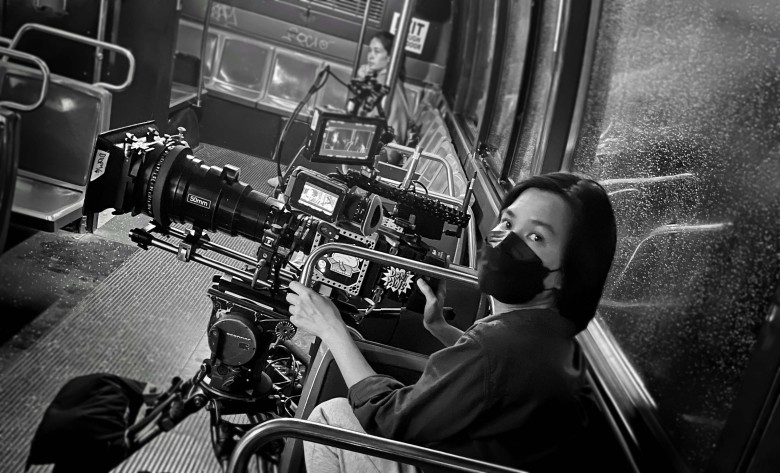
Behind the scenes of “birth/rebirth”
Tricia Mears
Dir: Laura Moss, DoP: Chananun Chotrungroj
Format: 3.4K ProRes 4444XQ anamorphic
Camera: Arri Alexa Mini
Lens: Panavision Primo Anamorphic primes
Chotrungroj: Given how tight our locations were, the compact size of the Alexa Mini allowed us to have a small footprint and film in a flexible way. The Anamorphic Primo lenses from Panavision helped craft the visual language of our film — the wide framing allowed us to layer actors in ways that emphasized tension. We also used the anamorphics’ bokeh and blurs to distort the characters and background, conjuring a subtle ghostly feeling.
One of the feelings the film explores is how dangerous giving birth can be. We wanted to show the real violence women sometimes go through when giving birth. I personally had a traumatic experience when I gave birth to my son. Laura and I talked deeply about the details of that experience together and tried to recreate the feeling through the use of Swing/Shift lenses. The Swing/Shift lenses helped create the perspective of a woman giving birth — that disorienting, out-of-place, vulnerable experience.

“Bravo, Burkina!”
Walé Oyéjidé
Dir: Walé Oyéjidé, DoP: Jake Saner
Format: AHD
Camera: Arri Alexa Mini
Lens: Cooke S4 Suite
Oyéjidé: This film was produced on two continents, in two very different landscapes. We traveled from the cool-green Italian countryside to a quaint village in Burkina Faso where the blazing sun was ever-present. We needed a camera that would travel lightly (across the ocean) while affording great latitude and dynamic range to capture European castles and small West African interiors. Despite the vastness, and occasional harshness of the differing landscapes required by the narrative, the priority or Jake Saner and I was always to produce a beautiful image. With every frame of this film, the Alexa Mini rendered our protagonists with grace and nobility.
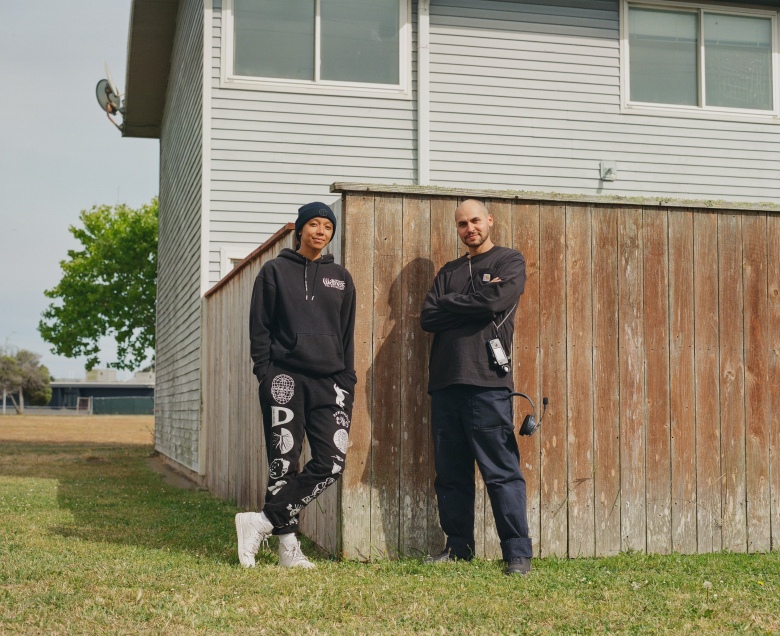
“Earth Mama” director Savannah Leaf (left) and cinematographer Jody Lee Lipes
Gabriel Saravia
Dir: Savanah Leaf, DoP: Jody Lee Lipes
Format: 16mm
Camera: Arri 416
Lens: Arri Master Primes and an Angénieux Optimo 12:1
Lipes: Savanah chose not to sugarcoat the main character’s struggle in the system she was born into, but simultaneously used magical realism to explore themes of Black motherhood in the film. So, ultimately there is a mixture of gritty reality and natural beauty in this story. It’s both social services offices and parking lots, and redwoods and nature. 16mm film helped us achieve the beauty and grittiness we were after. Savanah and I went through the script line by line many times, carefully choosing the coverage and camera movement precisely. In contrast to this rigorous shot-listing, the lighting is very basic, unshaped, and real. So there is an intentional aesthetic mixture in the movie of painstaking craft and a hands-off, unadorned lighting approach that fits the duality of Savanah’s story.
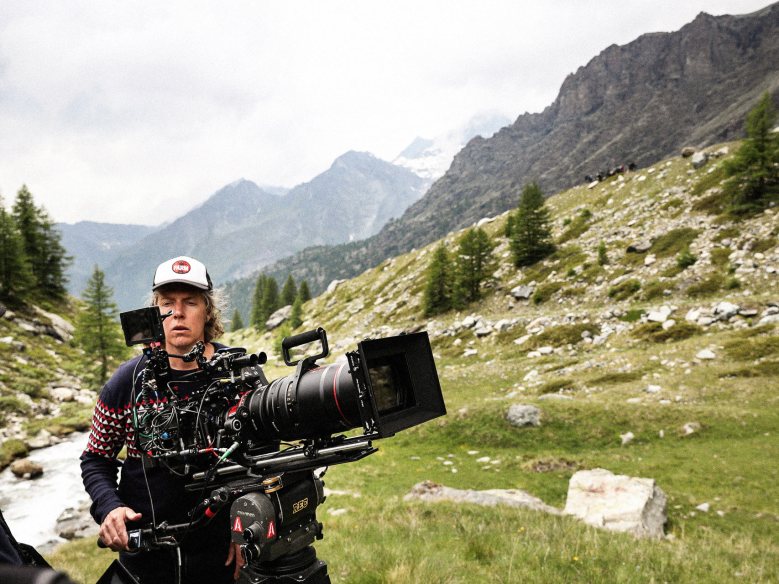
Behind the scenes of “The Eight Mountains”
courtesy of the filmmaker
Dir: Felix van Groeningen and Charlotte Vandermeersch, DoP: Ruben Impens
Format: Arriraw LF open gate
Camera: Arri Mini LF
Lens: Zeiss Supreme and Angénieux zoom FF
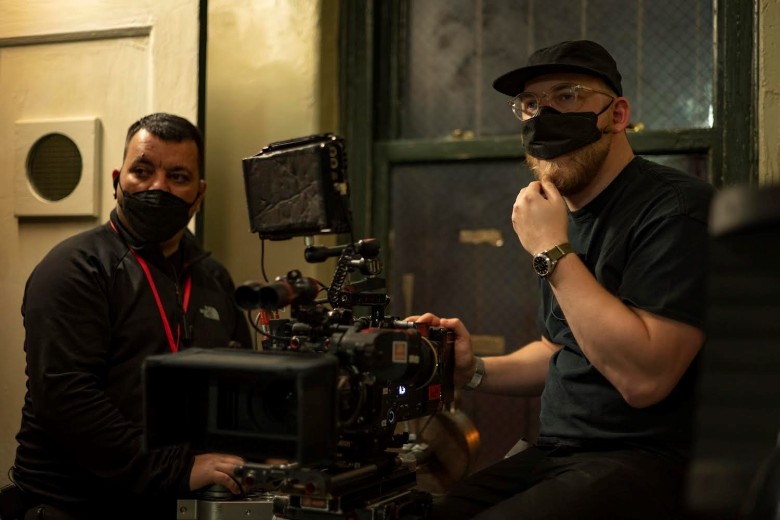
Behind the scenes of “Fair Play”
Courtesy of Filmmaker
Dir: Chloe Domont, DoP: Menno Mans
Format: 4K X-OCN XT anamorphic
Camera: Sony Venice
Lens: Cooke Anamorphic
Mans: We chose Cooke Anamorphics for their classic anamorphic character, while still giving us the flexibility and sharpness of modern glass. Stylistically we wanted the film to have an old-school thriller atmosphere, where the viewer immediately senses that something is off.
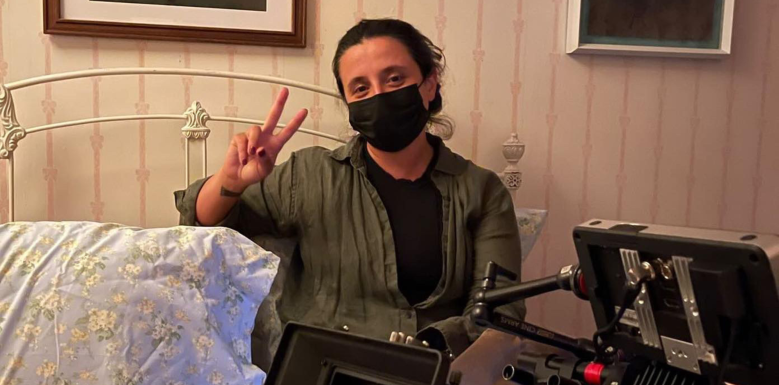
Behind the scenes of “Fancy Dance”
Courtesy of Filmmaker
Dir: Erica Tremblay, DoP: Carolina Costa
Format: Arriraw
Camera: Arri Alexa LF
Lens: Arri Signature Primes
Costa: Our philosophy when shooting “Fancy Dance” was “find beauty and magic in everyday life.” In the same way that we wanted to explore Jax and Roki’s beautiful, yet complicated, relationship, we also didn’t want to escape from the dark world around them. We couldn’t close an eye to the reality of indigenous women the same way the system does.
We knew we wanted the large format for this story — the idea was to have the camera close to these women, feel their presence, put them in the center (metaphorically and literally) and be able to see the world around them. The Signature have a beautiful rendition on skin and faces and that was also important for us, that the cinematography represented well the indigenous people sharing their stories.
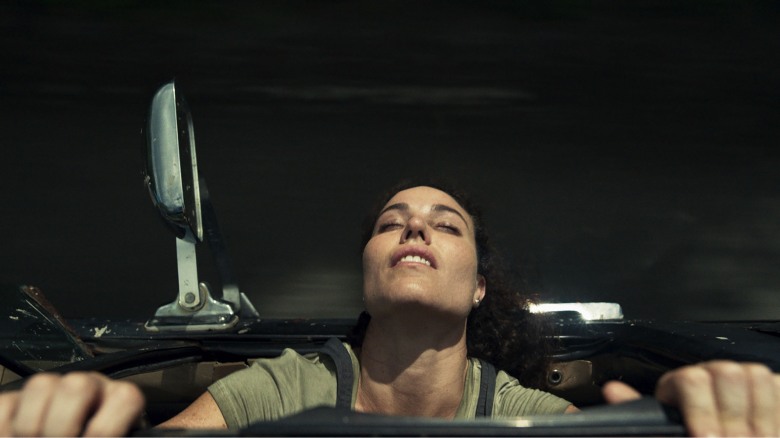
“The Fishbowl”
Sundance Institute
Dir: Glorimar Marrero, DoP: PJ Lopez
Format: 4.5K Arriraw
Camera: Arri Alexa Mini LF
Lens: Zeiss Supreme Radiance
Lopez: During the beginning of prep, specifically when doing the first readings, the director and I realized that we needed to tell the story handheld to achieve a special intimacy with our characters. We chose the Alexa Mini LF for its compactness and good 4.5K resolution. At that moment we had a camera! Then, we needed a lens set that provides texture and keeps us close to our actors without the need to use focus diopters, and that was when we found the Zeiss Supreme Radiance at PJ Gaffers Camera Division. We also did tests with the Leica R but the Radiance gave us the texture we wanted and the natural flares that the story was looking for. To complete our look we used a very natural style of lighting that was not very invasive to achieve a look more towards a documentary style. This is what our movie “The Fishbowl” is about: Camera in hand behind our main character who is in the process of dying, reuniting with herself.
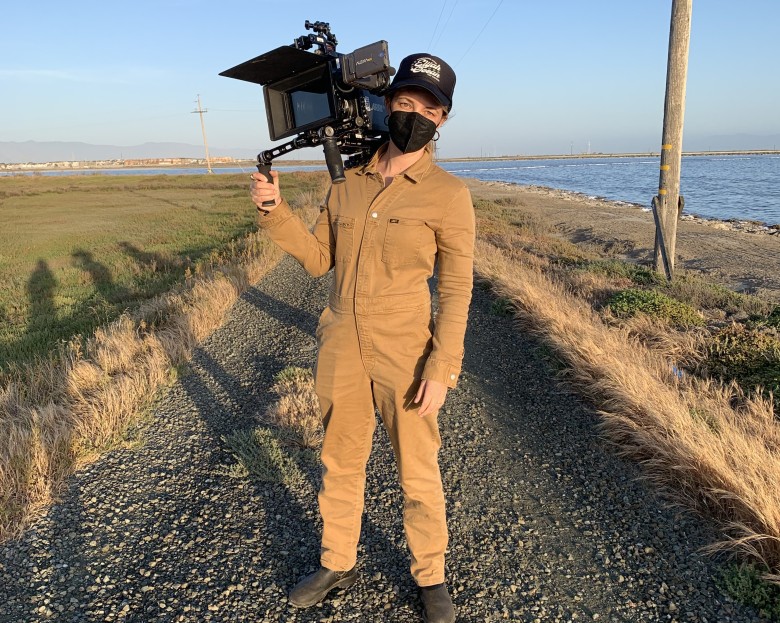
Behind the scenes of “Fremont”
courtesy of the filmmaker
Dir: Babak Jalali, DoP: Laura Valladao
Format: 2.8K Super 35 ProRes 444
Camera: Arri Alexa Mini
Lens: Cooke Speed Panchros
Valladao: While the aesthetics of San Francisco’s Chinatown and a Northern California suburb like Fremont may be somewhat familiar to many, it was important to Babak and I that in the film we experience these places as Donya does, with curiosity and new perspective. Photographing the film in black-and-white allows the audience to see the world with fresh eyes, leaning in to experience textures, patterns, and light, connecting us with Donya’s unique visceral experience from moment to moment.
From early on, Babak and my conversations about the black-and-white look were inspired by the works of our favorite still photographers. We knew we wanted lenses with just a touch of softness and bloom, while having enough sharpness and contrast to resolve nicely in the black-and-white image. The Cooke Speed Panchros did exactly this. They were versatile enough to perform well in situations with direct sun and large windows as well as create some poetic lens flares when the moment called for them. These lenses can vary from lens set to lens set and I really fell in love with our set from Videofax in San Francisco. The TLS rehouse gave us the magic of vintage glass with the speed and reliability of modern housing, which was essential as we were often switching between sticks and handheld within a setup.
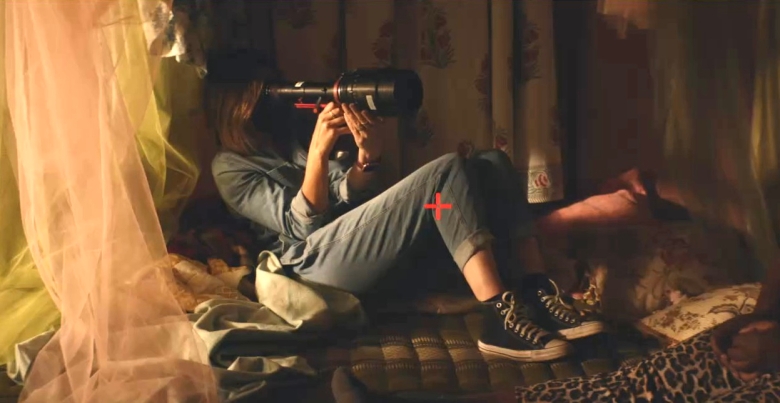
Behind the scenes of “Girl”
Tasha Back
Dir: Adura Onashile, DoP: Tasha Back
Format: Arriraw OG Anamorphic
Camera: Arri Alexa Mini
Lens: Cooke Anamorphics
Back: Adura was keen to find a magical look for the world Grace and Ama exist in but without it looking too unreal. I chose the Cookes because the felt like a good balance. By shooting wide open at times and leaning into the distortion of the edges of the lens I could have a more dreamlike look for certain scenes if required. We also used diopters for a lot of scenes where we wanted to be intimate with Ama and see the world through her eyes.
We used a handheld camera on many scenes to enable me to get close to the actors and be responsive to them. We chose a more solid style in the flat to reflect the calmer, safe environment they perceived their home to be.
Color was a major factor in the look of the film and in the lighting choices. I used RGB sources wherever I could to build color into the scenes. My gaffer Paul Joy and I worked closely with the production designer Soraya Gilanni Viljoen to use practical sources in every set and compliment the color choices she had made. I had many conversations with Soraya about textures, reflective surfaces, and window dressings. These things are such a big part of lighting and the effect light has in a room and the way it falls. In the studio we used a mixture of LED and HMI sources through the windows, bounced and/or diffused using a mixture of muslin and the textiles provided by Soraya.
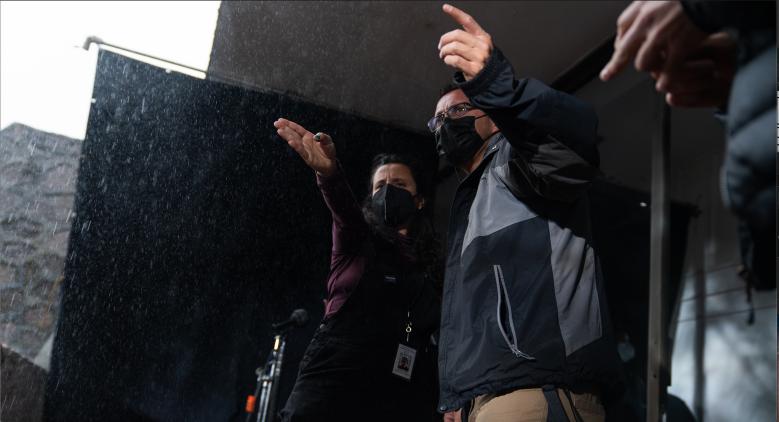
Behind the scenes of “Heroic”
courtesy of the filmmaker
Dir: David Zonana, DoP: Carolina Costa
Format: 3.2K
Camera: Arri Alexa Mini
Lens: Zeiss Super Speeds
Costa: This is the second film I shot for David. On the first one, “Workforce,” we really learned how to trust the actors (and natural actors) and created depth within a single frame. For “Heroic,” we expanded that language and added more movement. The camera moves not for spiritual or psychological reasons — it’s much more visceral. So the size and weight of the Alexa Mini really helped us move fast. Because most scenes are single shot masters, the composition had to be extremely thoughtful and precise. We rehearsed each shot many times before doing the take. That also helped since our cast was a mix of trained and natural actors. The speed of our lenses was essential since our lighting package was pretty small.
The way we framed the group shots was always to show the rigidity of this world, but also the toxic masculinity that exists in this group. The location was a character and we also wanted to express the battle between the system versus the man. We shot about 80 percent of the film with wide angles lenses, such as the 16mm and 18mm. The dream sequences are a key element in the narrative and it was a fine balance shooting those, because we didn’t want them to feel like a “fantasy” — they had to feel real and yet strange.
I am very familiar with the Alexa Mini and I feel comfortable shooting in higher ISO and pushing it a bit further. I really love the texture in that world. The exteriors of our location were rich but the interiors were basically bare white walls, so adding that “texture” on camera was super important.
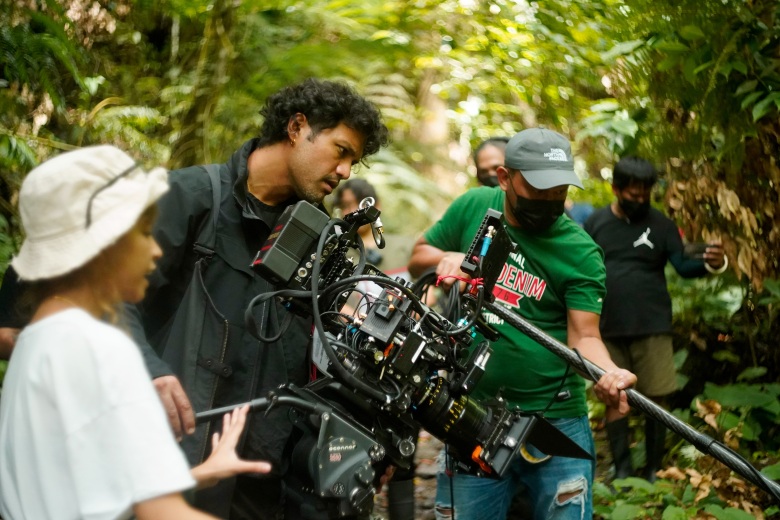
Behind the scenes of “In My Mother’s Skin”
Richard Visco
Dir: Kenneth Dagatan, DoP: Russell Morton
Format: 3.4K S35 Arriraw, 4.5K LF Arriraw
Camera: Arri Alexa Mini LF
Lens: Cooke Panchro/i, TLS Petzval 58mm, Angénieux Optimo Style 25-250mm T3.5 10x zoom
Morton: “In My Mother’s Skin” is a film set during World War II in the Philippines. I found the film to have a strong Catholic imagination and this provided an opportunity for us to reference religious paintings of the renaissance masters within the lighting and framing choices. The Panchro/i were an obvious choice for me as I felt that the focus roll offs of the Panchros remind me of brush strokes with oil and canvas and these characteristics lent its quality towards a more painterly image. In addition to that, the history of its optical design aligns with the period of the narrative of the film which made conceptual sense to me.
In the film, there is an encounter with a supernatural entity — a fairy. We opted to photograph some of the fairy scenes with a lens that has a strong, unique character that would help these encounters appear more magical and surreal. The TLS Petzval has a swirly bokeh effect in the out-of-focus regions and this gave the image a more dreamlike quality. However, to get the full effect of this lens, you would need to have a larger format sensor and the Panchros that we were using for the main sections of the film were Super 35. To address this, we opted to use the Arri Mini LF and interchange between LF and S35 mode when necessary in order to get the full effect of the Petzval.
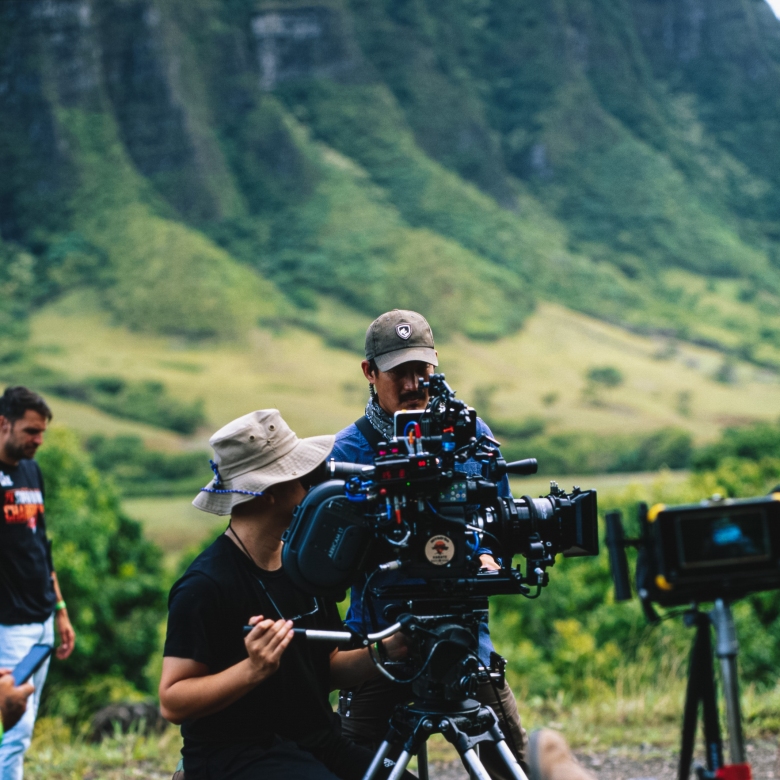
Behind the scenes of “Jamojaya”
David Matheny
Dir: Justin Chon, DoP: Ante Cheng
Format: 35mm 3-perf
Camera: Arricam LT, Sony Venice, Panasonic miniDV
Lens: Kowa Cine Prominars, Canon Rangefinder Primes, Canon K-35 zoom
Cheng: Honestly, we just wanted to shoot on 35mm film.
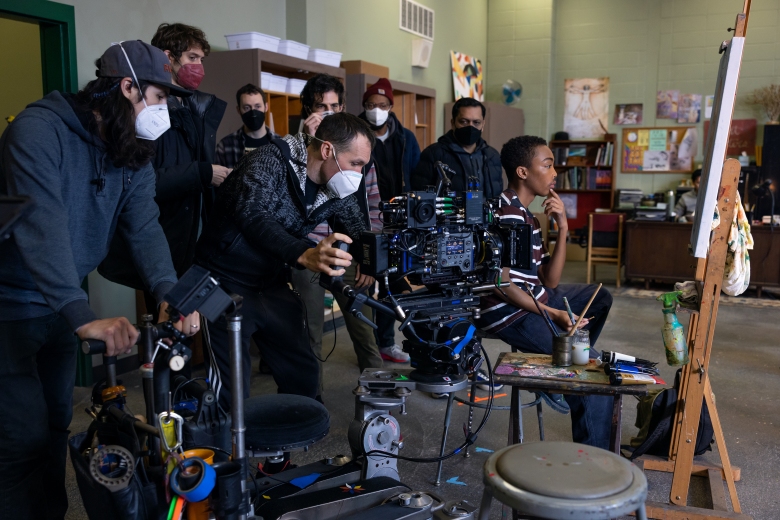
Director Cory Finley, cinematographer Lyle Vincent, and actor Asante Blackk on the set of “Landscape with Invisible Hand”
Lynsey Weatherspoon
Dir: Cory Finley, DoP: Lyle Vincent
Format: 4K Sony RAW 4.3
Camera: Sony Venice
Lens: TLS rehoused Bausch & Lomb Super Baltars
Vincent: We originally wanted to shoot on film because we loved working in the medium on “Bad Education.” We thought the grain and subtle texture of film would help marry our VFX seamlessly and also add a feeling of bygone era to the near future world where aliens have inhabited Earth. When shooting on film didn’t pan out we settled on the Venice with vintage Super Baltars as well as live film grain add to get as close as we could. We also played with the idea of old academy 1.33 aspect ratio but settled on the 16mm film gate and early European version of 35mm of 1.66 ratio. It also threw homage to one of our reference films, “A Clockwork Orange.”
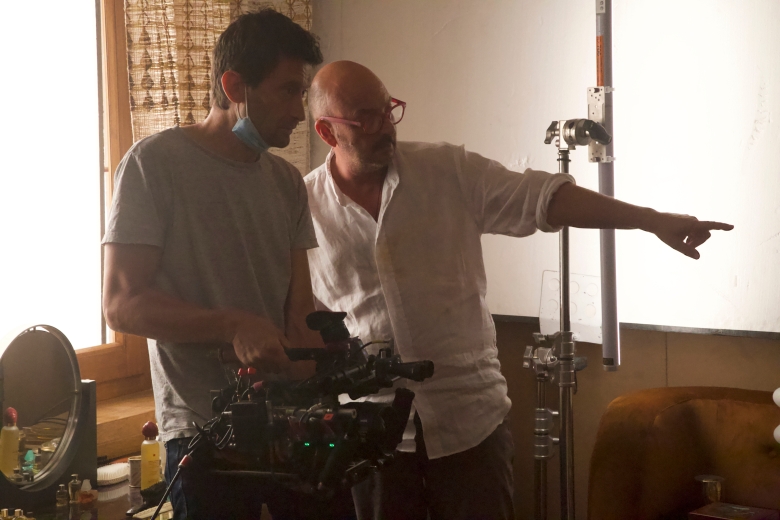
Behind the scenes of “L’immensitá”
Angelo Turetta
Dir: Emanuele Crialese, DoP: Gergely Poharnok
Format: 2.8K Arriraw
Camera: Arri Alexa Mini
Lens: Zeiss Supreme Prime
Poharnok: This is a period film, the story takes place in Rome in the ’70s. For me it was important that the audience experience this drama in the present moment, and watch it as if being there with this family. I felt if we use a visual language that tries to imitate the cinema of the ’70s, or if we over-stylize the images, it would create a distance between the viewer and our characters.
Penélope Cruz plays the mother, and with her wherever you put your light or camera she just looks fantastic. In the film she is a mother who goes through lots of trauma. If we showed her too glamorous, that would have been totally wrong for the story. We liked the imperfection and bit of noise in the standard Alexa Mini image, so we chose not to shoot with a large format sensor. For the lens we tested many vintage and modern glasses. We didn’t like flares or distortion, but preferred lenses that had a clean but soft character. Supreme turned out to be the right choice for this film. The Alexa Mini and the Supremes helped us to tell this very intimate and personal story in the right way.
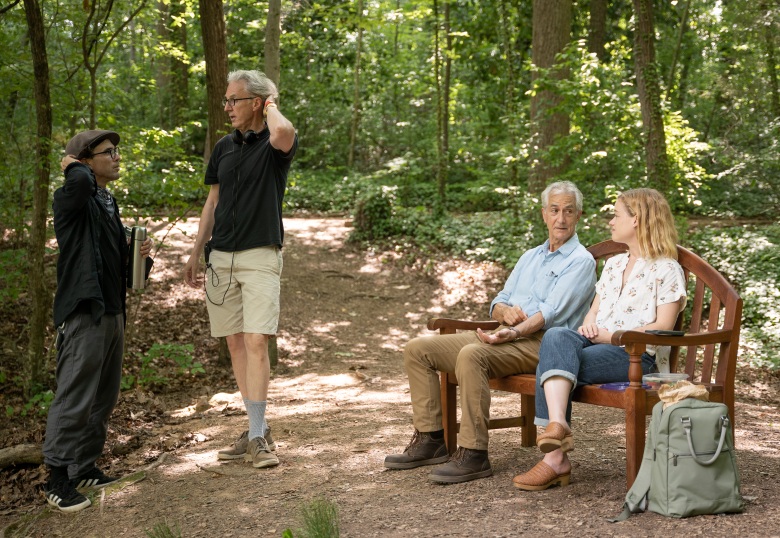
Behind the scenes of “A Little Prayer”
Joshua Campell
Dir: Angus MacLachlan, DoP: Scott Miller
Format: 4.5K ProRes 4444HQ 3:2 open gate
Camera: Arri Alexa Mini LF
Lens: Canon K35 primes 24mm, 35mm, 45mm, 55mm, 85mm
Miller: “A Little Prayer” reveals the complex dynamics centered around a family in the South, as our characters unexpectedly find ways to connect with each other, and maintain the bonds of love.
Part of the approach for “A Little Prayer” was to give space on the set to the actors and the director, lighting when possible with large bounce sources outside, accentuated with a small mirror or two to create hot spots of light. The lensing approach went hand in hand, keeping the photography simple, finding the right place for the camera, and maintaining a wider frame. We sought to create a portrait of a multigenerational family. While the characters in the story navigate challenges and darker emotions, the camera and the lighting were to accentuate the warmth and love still between the family.
I was very fortunate to begin a Zoom dialogue with the director about six months before the shoot. It was precious time, as we would have a short prep on the ground. Angus brought in references including The Hudson River School painters, the photography of Henri Cartier-Bresson, and the cinematography of Néstor Almendros. We explored the quality of light and color from these artists’ work.
“A Little Prayer” was filmed entirely on location in Winston-Salem, NC, and the compact size of the Mini LF allowed us keep a small footprint. Paired with the Canon K35s, this lent a softness and naturalism to the image. As the shoot progressed, we began to rely on the 45mm focal length. I often find there is a lens that becomes the hero lens on a shoot, and for us it was the 45mm. We decided to use the larger format and embrace an aspect ratio of 1.59. For me, this contributed to a feeling of bearing witness to a home and family, akin to that of a photograph or canvas.
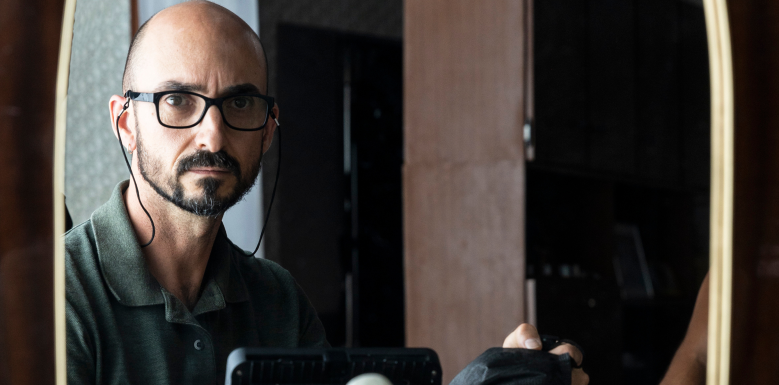
Behind the scenes of “Mamacruz”
Courtesy of Filmmaker
Dir: Patricia Ortega, DoP: Fran Fernández-Pardo
Format: Arriraw
Camera: Arri Alexa Mini LF
Lens: Cooke S7
Fernández-Pardo: We recorded on Alexa Mini LF. I always trigger on Alexa. When I try another camera, I always regret my decision and want to go back to Alexa. The lenses we used were Cooke S7. I was looking for a soft lens to create contrast with the lighting. The idea was to visually accompany the changes of the protagonist. The story evolves from winter settings to summer settings. The diffused, soft, and cold light of winter represents the monotony of Cruz’s life. In winter the sun is closer to the horizon throughout the day, so it is difficult for him to enter a small house in a neighborhood with narrow streets. When there are no shadows, there are no doubts. Everything is seen, everything is known, everything is monotonous. Cruz changes and the environment gains warmth, contrast, direct light, and shadows. We are approaching summer. The shadows represent what we do not see, what can be discovered. The same thing that Cruz is doing with his life.
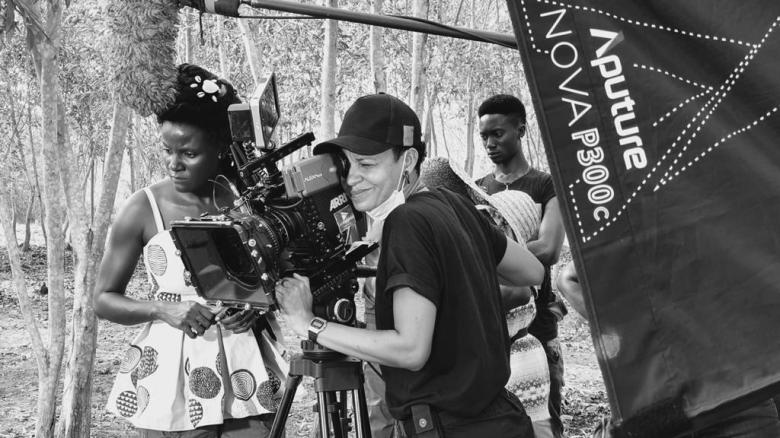
Behind the scenes of “Mami Wata”
courtesy of the filmmaker
Dir: C.J.Obasi, DoP: Lílis Soares
Format: Arriraw
Camera: Arri Alexa Mini
Lens: Zeiss CP3 and Angénieux zoom
Soares: “Mami Wata” is an aesthetically daring film. The choice of director C.J. Obasi to make a film in black-and-white with 99 percent of actors with jet black skin, shot essentially at night, either on the beach or in the forest, and with an ancestral African theme would be a great challenge. However, in a short time, we understood that the pandemic and structural issues would make our process even more difficult. Many adaptations were necessary in my initial planning. The equipment was coming from Nigeria to Benin, the country where we recorded, and we had a very long delay in delivery, which also brought difficulties in terms of the filming plan. I think what defines this project is the creativity to find technical and narrative solutions for the scenes.
A filmic process like this says a lot about what it will become and which pieces are in fact fundamental for sustaining an aesthetic unity. As a cinematographer, I had in my hands an incredible opportunity to visit my roots and explore Black and diasporic aesthetic codes in depth. My personal and professional research object is precisely the search for insertion of codes and messages in image creation. Understanding what new gaze really is, and how my trajectory and technique can influence narratively and creatively the production of images. Alexa is my favorite camera and together with the quality of the Zeiss lenses and Angénieux zoom lenses I was able to get interesting results many times in terms of texture, depth of field and movements. The Black skin, the texture of the sea, the contrasts and the brightness of the night were important elements in this experiment and, as an essay, we could see in images that there is a Black African narrative aesthetic, a story that plays with the senses, with the occult, which still needs to be looked at with more responsibility and sensitivity.
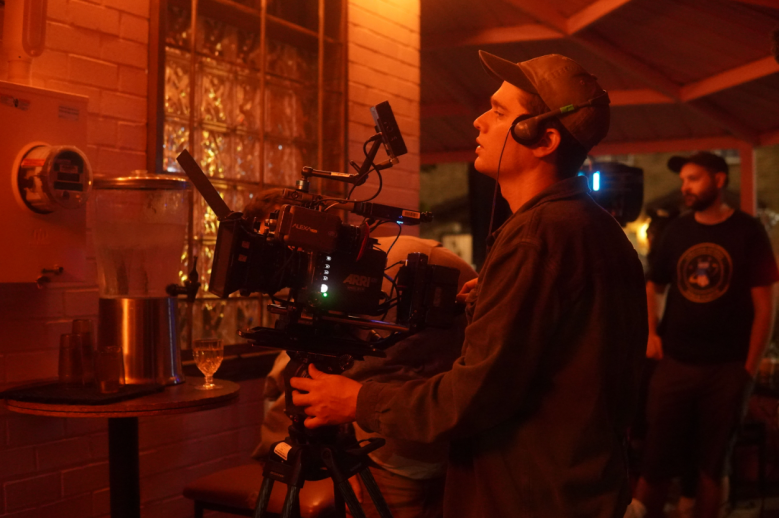
Behind the scenes of “Mutt”
courtesy of the filmmaker
Dir: Vuk Lungulov-Klotz, DoP: Matthew Pothier
Format: Arri 4:3 open gate
Camera: Arri Alexa Mini
Lens: Leica Noctilux 50mm .95 and Summicron
Pothier: We shot probably 80-plus percent of the movie on the 50mm Leica Noctilux which is a really fast T.95 lens. We wanted the movie to feel like a series of medium format photographs, but also to capture the energy of the city. Keeping the camera package simple and realistic to our constraints gave us the most flexibility to adapt to the chaos that is shooting a micro budget movie in stolen and borrowed locations deep in the heart of Bushwick, Brooklyn. But also from a practical standpoint we had a tiny, and sometimes nonexistent, lighting team so having a lens that would shoot in the darkest of conditions proved to be invaluable. Huge shoutout and thanks to our tiny but mighty G/E, camera, art, and production teams.
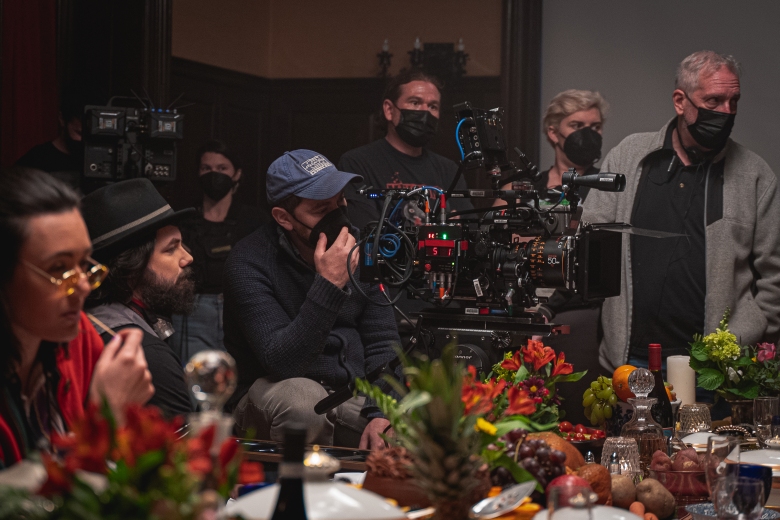
Behind the scenes of “Onyx the Fortuitous and the Talisman of Souls”
Justin Allen
Dir: Andrew Bowser, DoP: Dan Adlerstein
Format: 2.8K ProRes4444XQ 4:3 2x squeeze
Camera: Arri Alexa Mini
Lens: Atlas Orion Anamorphics
Adlerstein: There was a fine balance to strike in shooting a character-based throwback horror-comedy meant to be fun, spooky, and emotional all at once. And one of the first decisions director Andrew Bowser and I made about the look and feel of “Onyx” was for it to be shot anamorphic. Yes, we wanted that grand and epic feel that anamorphic can help provide. But also: “Onyx” is an ensemble piece, and the 2.39 aspect ratio would allow for more natural framing of group shots. We wanted to get creative with negative space. We wanted the shallow depth of field to give a sense of mystery to the surroundings. And knowing we’d have many candles in the background of shots, we thought the anamorphic bokeh would help reinforce the gothic mood and atmosphere of the location. What surprised me on set was how much I wound up reaching for the wider focal lengths for close-ups and mediums. I can’t say that was the original plan, but especially with the main character of Onyx himself, we found ourselves loving the feel of the 40mm and even 32mm just a few feet away. Not only did it feel intimate by bringing the viewer into Onyx’s subjective experience, but we found these shots to be fun and dynamic as well — a big part of that balance we were striving for.
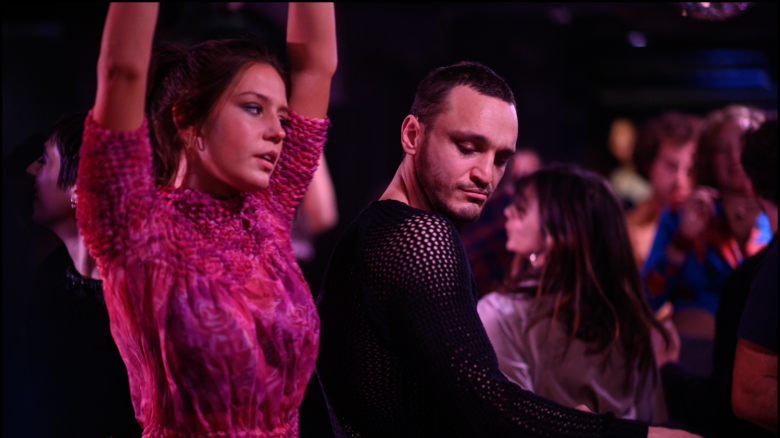
“Passages”
Courtesy Sundance Institute
Dir: Ira Sachs, DoP: Josee Deshaies
Format: 3.2K
Camera: Arri Alexa Mini
Lens: Cooke S4
Deshaies: When not shooting on film, I love the Alexa. It’s like an old friend (you excuse the faults and really appreciate the qualities). The film was shot on a very small budget and on a short schedule. I wanted to experiment not with the equipment but more with the director’s mise en scène, the acting, and the length of some shots. The film is about intimacy, the power of humans over other humans, the beginning and the end of things (passages). I didn’t want the technique to get in our way of telling the story but to be a gentle companion.
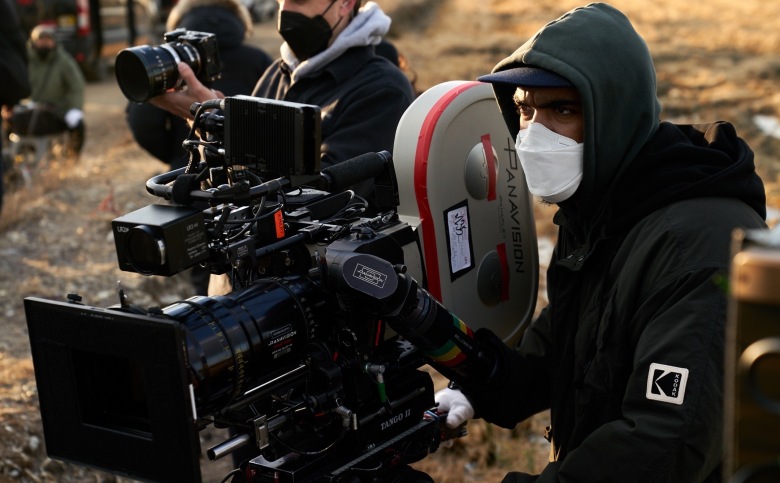
Shooting “Past Lives”
John Pack
Dir: Celine Song, DoP: Shabier Kirchner
Format: 35mm 3-perf
Camera: Panavision XL2
Lens: P vintage, Panavision Ultra speed’s, Primo Zooms
Kirchner: During the early stages of pre-production Celine and I discussed the conceptual ideas behind “Time” and “Love” and how to best bring those qualities to the image in harmony with the script. 35mm film naturally became a deep part of our conversations and eventually our philosophy when developing the visual language of the film. We push-processed the entire picture by at least +1 stop and in some cases pull processed -2 stops in order achieve the desired feeling in the contrast, grain, and overall softness. Panavision worked with us on putting together the perfect set of lenses needed to frame the characters’ faces as our landscapes.
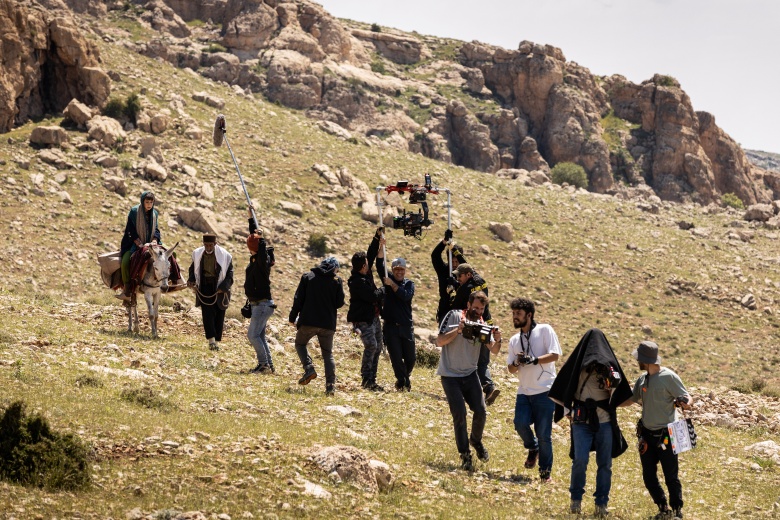
Behind the scenes of “The Persian Version”
Yiğit Eken
Dir: Maryam Keshavarz, DoP: André Jäger
Format: 3.4K Arriraw
Camera: Arri Alexa Mini
Lens: Cooke S7i
Jäger: I knew from a very early stage that the Mini would be the perfect tool for us since we would be shooting mostly handheld and Steadicam on location, in a wide range of environments under all kind of weather conditions. Choosing the perfect lens was the bigger challenge. Since our story takes place in different decades, I considered shooting anamorphic because of the timeless look they deliver. Moreover, one of the things Maryam repeated throughout the whole production was that we should embrace the imperfection. So it made even more sense to me to go for anamorphic lenses because of characteristics like their susceptibility to flares. But after testing a variety of lenses (spherical and anamorphic) on different cameras we felt that anamorphic wouldn’t be the right choice for our needs.
We needed a more versatile set of lenses to be able to shoot in small spaces and without worrying constantly about close focus. After discussing the test results with Maryam, the Cooke S7 with their natural look, the soft rolling off focus in combination with the Alexa Mini was what excited us the most. In particular, the way the Cooke S7 capture different kinds of skin tones and their natural rendering convinced us. Of course choosing the S7 was a bit contrary to my original plan of having a small and lightweight camera build. So we took a set of Cooke S4 along with us. They match perfectly with the S7 and I used them for smaller camera builds whenever needed.

Cinematographer Andrij Parekh and director Sophie Barthes on “The Pod Generation”
Isabel Palomar
Dir: Sophie Barthes, DoP: Andrij Parekh
Format: 4.5K Arriraw
Camera: Arri Alexa Mini LF
Lens: Tribe 7 Blackwing primes
Parekh: Creating the look for “The Pod Generation” proved to be an interesting challenge. As the film is “near-fi sci-fi,” and the main theme of the film is birth and re-connecting to nature, we wanted to avoid the traditional sci-fi genre tropes and instead wanted the created world to feel softer, rounder, more pastel, more feminine, and so we chose colors and a palette and design that would lean into that approach. Compositions in the city tended toward more formal, and once the film ventures into nature, the style became much looser. I use available light as much as possible, and this also lent a more organic feel to the process of filmmaking. And as the budget was incredibly tight and we were relying on little artificial lighting, the Alexa LF and the fast Blackwing primes were an excellent choice to realize Sophie’s vision.
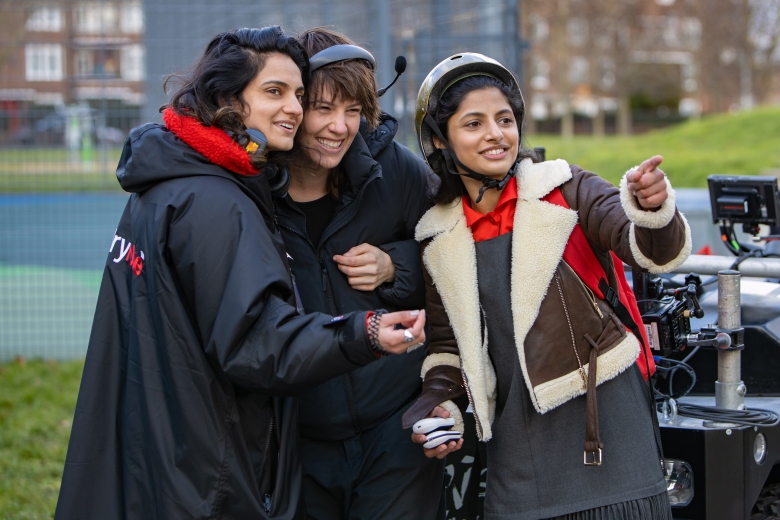
Director Nida Manzoor, cinematographer Ashley Connor and actor Priya Kansara on the set of their film “Polite Society”
Saima Khalid
Dir: Nida Manzoor, DoP: Ashley Connor
Format: 2.8K ProRes4444 4:3
Camera: Arri Alexa Mini
Lens: Cooke Anamorphic
Connor: Nida and I chose to go anamorphic because it felt in line with the genre we were playing within. We wanted Ria’s world to be big and colorful which was heavily achieved through the production and costume design, beautifully done by Simon Walker and PC Williams. We wanted the action to play loud yet be grounded in an idiosyncratic style. The Cookes ended up yielding a certain level of intimacy while not attributing too many anamorphic characteristics to the image.
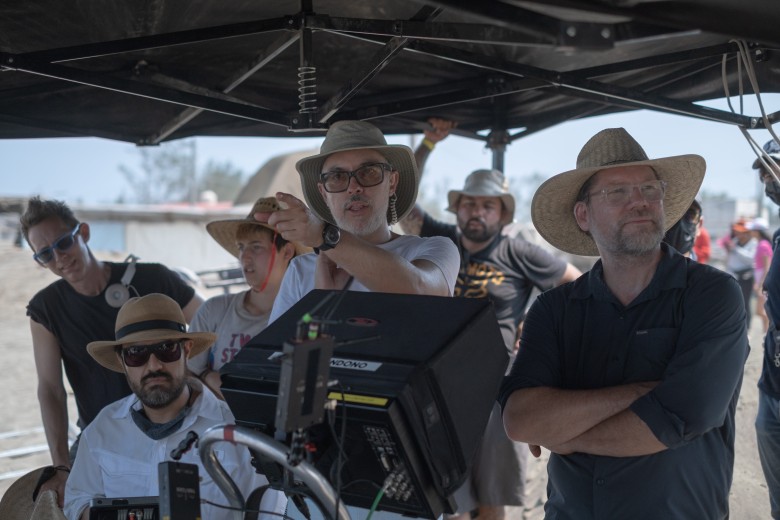
Behind the scenes of “Radical”
courtesy of the filmmaker
Dir: Christopher Zalla, DoP: Mateo Londono
Format: We captured in 4.5K Arriraw open gate, framing for 2.39:1 aspect ratio
Camera: The cameras we used were Arri Alexa Mini LF, mostly using two cameras and sometimes even three in the classroom scenes with lots of kids
Lens: For lenses we used a combination of rehoused Canon K-35 with Canon EF primes and occasionally a Zeiss Compact Zoom 70-200mm. These lenses let us take advantage of the large format sensor of the Mini LF.
Londono: We used the Canon K-35 and EF lenses for their softer and non-clinical feel. These lenses were manufactured in Japan in the 1970s and ’80s, many of them by hand, and therefore lack the “perfection” of modern lenses. Christopher Zalla and I wanted to lean into these “imperfections” to achieve a look that felt less controlled without making it gritty. This was our approach for framing and lighting as well. Sometimes going as far as framing out people’s heads or characters all together. Sometimes we would intentionally break the line during coverage to cause a sense of confusion. We favored what could be considered as “mistakes” in classic filmmaking. Our story takes place in a Mexican boarder town plagued with neglect, corruption, and violence. The main character in the film, Sergio, is a teacher (played by Eugenio Derbez), who is trying a method to break through to his students’ apathy and unlock their potential. This path is in no way a straightforward one where there are some successes and some failures. We felt that approaching the cinematography in this way would support his and his students’ journey.
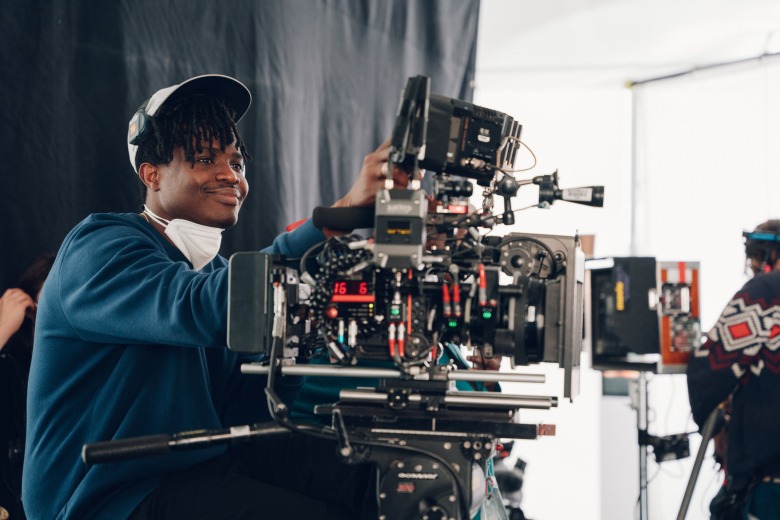
Behind the scenes of “Rye Lane”
Chris Harris/Courtesy of Searchlight
Dir: Raine Allen-Miller, DoP: Olan Collardy
Format: 2.8K Arriraw
Camera: Arri Alexa Mini
Lens: JDC Xtal Xpress Anamorphic Lens
Collardy: For “Rye Lane,” I chose to shoot with the Arri Alexa Mini, as I have found it to be one of the best digital cameras on the market in terms of color rendition and skin-tone reproduction. These two factors were of paramount importance to me, given the nature of the world and the characters we were capturing on film.
In my conversations with Raine, we agreed on pushing the boundaries of the genre, striving for something that was edgier, distinct, and visually striking. We wanted to create a film that stood out for its unique identity and visual language, all the while staying true to life and relatable to audiences. In order to achieve this, we decided that anamorphic format would be the best approach as it allowed us to create an image that was grand in scope, while still capturing the complexities of human experience that was at the heart of the subject matter.
After extensive experimentation with various lenses, I found that the JDC Xtal Xpress High Speed Anamorphic lens set was the perfect tool for our visual storytelling. These lenses, with their vintage character and charm, provided us with a distinct and beautiful aesthetic that elevated the film’s visual language. The 24mm focal length quickly became our go-to for its ability to transform every frame into a vibrant and striking image, capturing the unique distortions that were perfect for the style and story of the film. The lenses were an integral part of our visual language, bringing the film’s atmosphere and characters to life in a way that was both captivating and memorable.
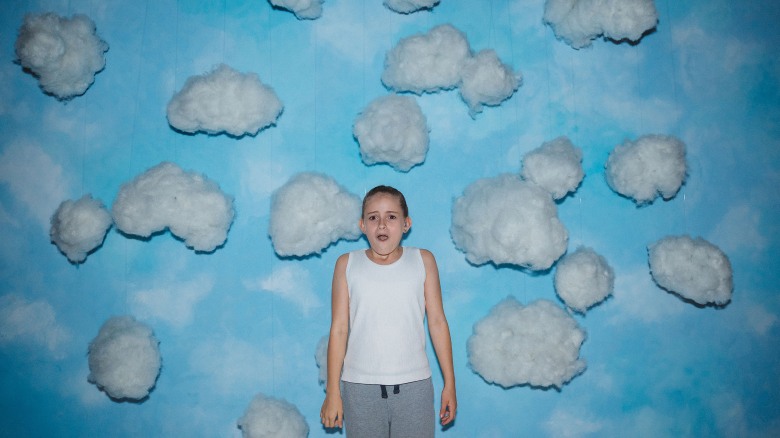
“Scrapper”
Chris Harris/Sundance Institute
Dir: Charlotte Regan, DoP: Molly Manning Walker
Format: ProRes
Camera: Arri Alexa Mini
Lens: Meru anamorphics
Bareiša: “Scrapper” is the story of a young quirky girl who runs her own life after her mother dies suddenly. The story is told from the kid’s perspective. We really wanted to heighten the world. We wanted to really encapsulate the amazing brain of young kids. Everything we did was to add a magical element to the storytelling. Our aim was to avoid the classical British estate drama which is often portrayed in a gritty gray and “real way.” The Merus add a soft magical element to the world and took it a step away from reality.
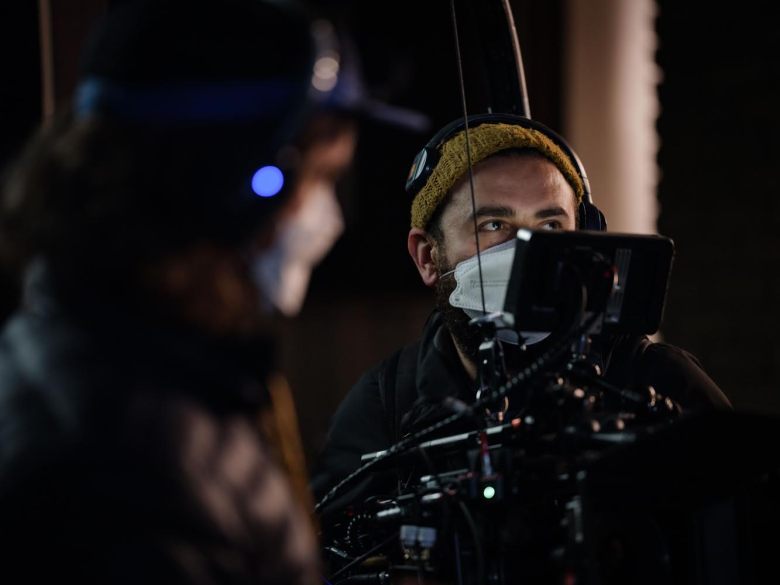
Shooting “Shayda”
Jane Zhang
Dir: Noora Niasari, DoP: Sherwin Akbarzadeh
Format: ProRes 4444XQ
Camera: Arri Alexa Mini
Lens: Panavision Primo
Akbarzadeh: We wanted to shoot on film but never really entertained it because we knew we’d be working with a child actor and doing long, unstructured takes. So I shot on the Alexa Mini, which has been my go-to for many years. I opted for a Super35 sensor over the LF because it feels like a more natural perspective to me and I wanted the camera to feel unobtrusive. We also wanted it to feel a bit like celluloid without relying on film grain in the DI. Shooting the Alexa at 1600 ISO gives the image a filmic quality not only in the embedded noise structure but in the tonal curve which favors information in the highlights rather than the shadows. We used Panavision Primo lenses which have a nice sharpness to them without betraying our 90s period feel.
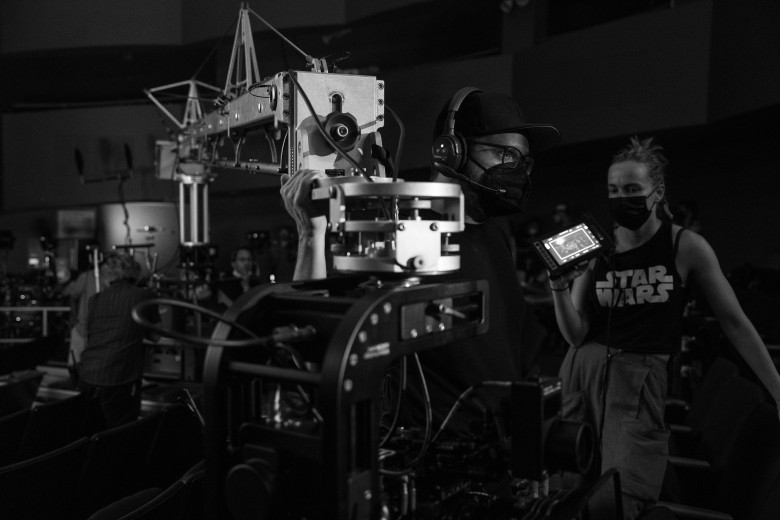
Behind the scenes of “Shortcomings”
Jon Pack
Dir: Randall Park, DoP: Santiago Gonzalez
Format: 3.8k ProRes 4444 LogC
Camera: Arri Alexa Mini LF
Lens: TLS rehoused Canon Rangefinders and Hawk V-lite Anamorphics
Gonzalez: After testing numerous lenses, Randall and I ultimately decided to pair the Mini LF with Canon Rangefinders. I loved how this combination rendered natural-looking skin tones and softened highlights, creating a subtle bloom — and the focus fall-off from center frame. While we went for a stylized look, we still wanted to preserve a natural and authentic feeling, and the Rangefinders did just that. Furthermore, we collaborated with our amazing colorist, Billy Hobson from Harbor Picture Company, to differentiate the cities’ visuals in the film. Billy helped us design different LUTs to convey a cooler atmosphere in the Bay Area versus a warmer one in NYC. Additionally, in one section of the film, we shot anamorphic, pushing the stylization closer to fantasy.

Shooting “Slow”
Andrius Aleksandravičius
Dir: Marija Kavtaradze, DoP: Laurynas Bareiša
Format: 16mm
Camera: Aaton XTR S16
Lens: Zeiss Ultra 16
Bareiša: We shot on the Aaton XTR S16. The film was shot entirely handheld and Aaton is really comfortable to use in this configuration. The lenses were Arri Zeiss Ultra 16 and these were pretty much the only ones available for 16mm at that time here.
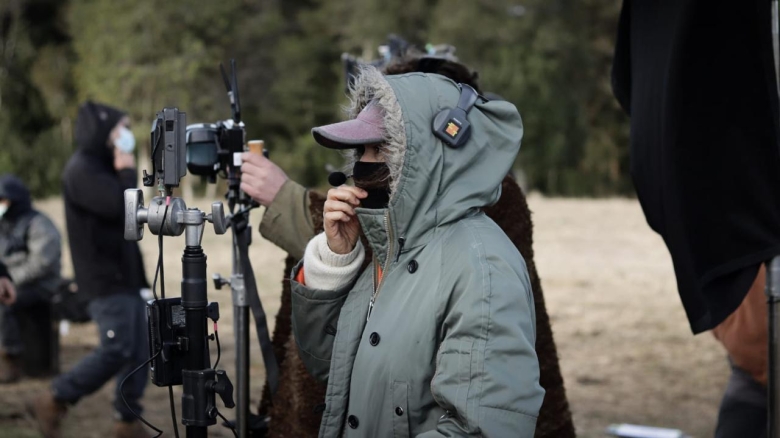
Behind the scenes of “Sorcery”
Maria Secco
Dir: Christopher Murray, DoP: Maria Secco
Format: 3.8K Arriraw
Camera: Arri Alexa Mini
Lens: Cooke S7
Secco: What most drew me to the movie, apart from the script which I loved, was the anthropological investigation Christopher had been working on in the island where the past events and the present would be related. Also, the idea of shooting on such a remote island, in winter, with very rare climate and light situations was very appealing.
The shooting was only four and a half weeks long, with multiple challenges. For that reason, we decided to work with Trinity operator Mirko Zlatar, almost all the time — even in some wonderful scenes completely under the rain which was a constant — so the Alexa Mini was a very good choice. Also the anamorphic format was something Christopher and I both wanted to explore in the island landscapes and with the characters close-ups, and the Cooke S7 contrast and color was a good choice. Though we didn’t have the opportunity to take the 65mm close focus, which I missed it quite a lot. The light equipment was very little, and we lit a lot of the night scenes and interiors with real fire to be used behind the camera and as props, maximized with light stream reflectors.
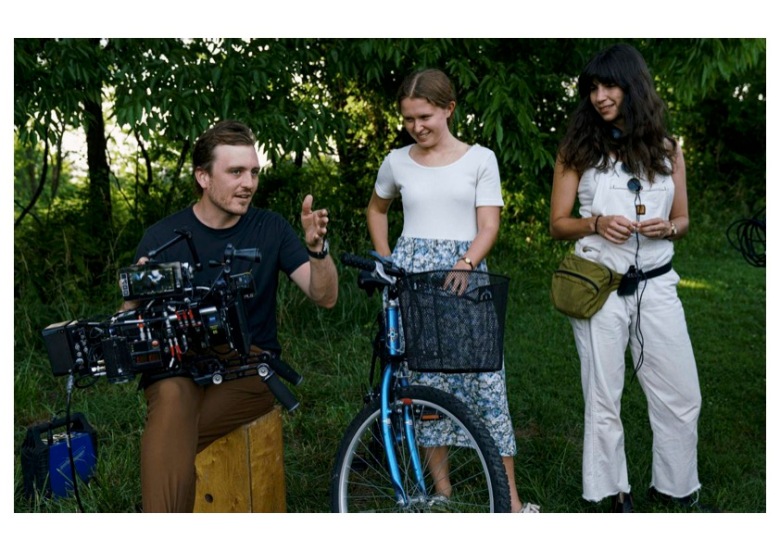
Behind the scenes of “The Starling Girl”
Dir: Laurel Parmet, DoP: Brian Lannin
Format: ARRIRAW 4.5K LF 3:2 OpenGate (1:85 crop)
Camera: Arri Alexa Mini LF
Lens: Zeiss Supreme Primes
Lannin: The choice of camera and lenses were both practical and creative. I wanted something small, fast, and beautiful and the Alexa Mini LF and Supreme Primes gave us all of that. I also happened to own the camera and lenses, so it afforded a lot of flexibility to the production and helped us put our limited resources into other things.
This film is rooted in Jem Starling’s POV (our main character, played by the incredible Eliza Scanlen). She’s in every scene and we are experiencing things with her, in the moment. I wanted the photography to be very present, intimate, somewhat reactionary, and subjective, without being too dogmatic in terms of its subjectivity. The camera needed to always be moving with her, able to hold close focus, in small practical locations, often on my shoulder, so a compact system with spherical lenses was crucial. The entire package had to be nimble and manageable for our small crew as well. It was a very simple camera package, just a single box of lenses!
We also wanted the movie to have a strong timeless print film look, that could capture the raw emotion of Eliza Scanlen’s face in a way that was beautiful, without being polished, and enhance the lush landscapes and textures of rural Kentucky, where the film is set. We developed our look prior to shooting with Sean Coleman, our colorist. I knew that the Alexa was the right sensor to deliver what we were after as I have been working with it for many years.

Behind the scenes of “Talk to Me”
Mathew Thorne
Dir: Danny Philippou and Michael Philippou, DoP: Aaron Mclisky
Format: 4.5K Arriraw
Camera: Arri Alexa Mini LF
Lens: Zeiss Supreme Primes
Mclisky: Since “Talk to Me” is a contemporary suburban teen horror set mainly at night, I jumped at the chance to pair the Alexa Mini LF with a set of Zeiss Supreme Primes. I needed a package that would give me the ability to lift the shadows in moments with a fast stop. The boys like to work fast — go ‘RACKA’ as we would say — this meant having a camera and lens package that I could be flexible with whilst maintaining a look we were all happy with. We wanted a modern look, nothing too fruity and nothing to clean. Pairing the Supremes with 1/4 Glimmer Glass was our go to for subtly lifting blacks and blooming the highlights.
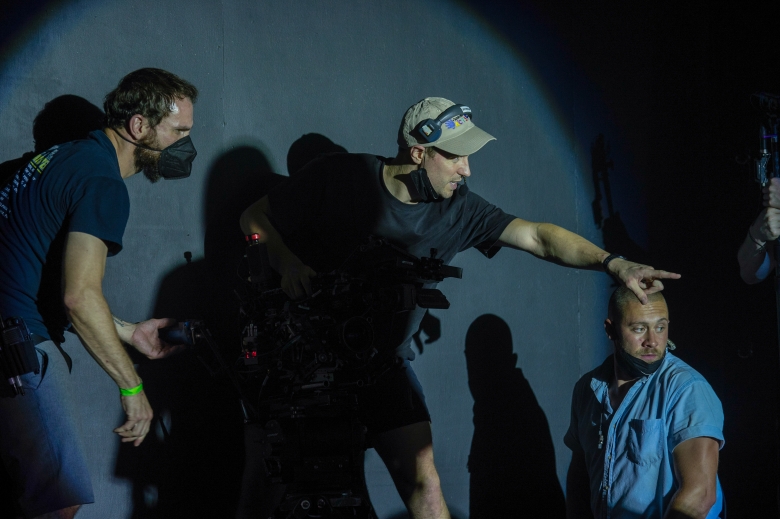
Behind the scenes of “Theater Camp”
Jeong Park
Dir: Molly Gordan and Nick Lieberman, DoP: Nate Hurtsellers
Format: Alexa S16HD
Camera: Arri Alexa Mini
Lens: Canon s16 8-64mm, Canon s16 6.6-66mm, Canon s16 11-165mm
Hurtsellers: For the mockumentary “Theater Camp,” we took visual inspiration from the roughly fashioned camera work of many iconic documentaries (“Jesus Camp,” “The War Room,” “Grey Gardens”). We wanted to undercut the absurdity and comedy with imprecise, “caught” visuals — naturalistic lighting, observational lensing, and a general sense of the camera trying to keep up with the action.
Improvisation was a big part of the comedy, so almost everything was cross-shot and handheld. Having a lightweight, flexible setup was critical. Embracing the s16HD format really became critical to the look. The Canon s16 zooms are fast, light, and have significant focal range. The deeper stop and somewhat degraded images helped push us towards a lo-fi, 16mm-ish look.
As the characters in the film become more and more comfortable with our fictionalized documentary crew, we allowed ourselves to get closer and closer to the eye lines and the action. There’s a lot of heart in the film. It was important that we not stay far away for too long. I loved the 8mm two feet away from a face. It could be both hilarious and intimate.
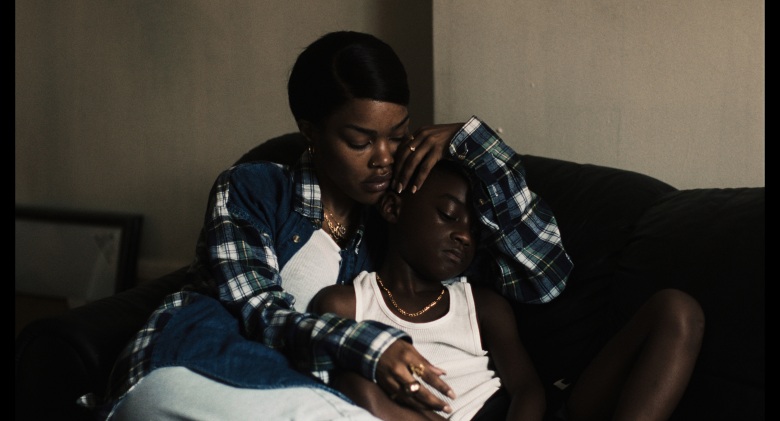
“A Thousand and One”
courtesy of Focus Features
Dir: A.V. Rockwell, DoP: Eric K. Yue
Format: 3.2K
Camera: Arri Alexa Mini
Lens: Panavision Super Speeds and Panavision Primos
Yue: We shot the film with two sets of lenses: Panavision Super Speeds and Panavision Primos. The ’90s section was shot with the vintage Super Speeds wide open with a 1/8 Black Pro Mist, for a softer and grainier image. The 2000s section was photographed with Primos without filtration at T2.8 or higher which produces a cooler, sharper, and crisper image. Their world becomes colder and darker as the two become distant from each other and their surroundings over the years. I wanted to use vintage and modern lenses to subtly suggest an emotion and temporal shift in the visual language.

Behind the scenes of “When It Melts”
Thomas Sweertvaegher
Dir: Veerle Baetens, DoP: Frederic Van Zandycke
Format: 2.8K ProRess 444 anamorphic
Camera: Arri Alexa Mini LF
Lens: Cooke Anamorphics 1.8x FF SF (50mm, 75 mm, 100 mm, 135mm)
Van Zandycke: I’ve worked with these lenses before so I knew exactly what they would bring to the table. My first idea was to go for the 16:9 ratio with some old lenses to give a certain reality to it but then I felt I wanted to add just that little bit more distance with what your eye perceives. They also maintain sharpness with our blooming away. These lenses are anamorphic but don’t over-exaggerate this look. It just gives the bokeh that little subtle touch that I love. In the past storyline in this film most of the scenes were shot on the 50 and 75 mm with 1/4 glimmer in the matte box. The journey starts wide and open and it slowly creeps closer and rules out establishing since we didn’t feel the need for it. The present storyline was mostly shot on 100 and 135mm.
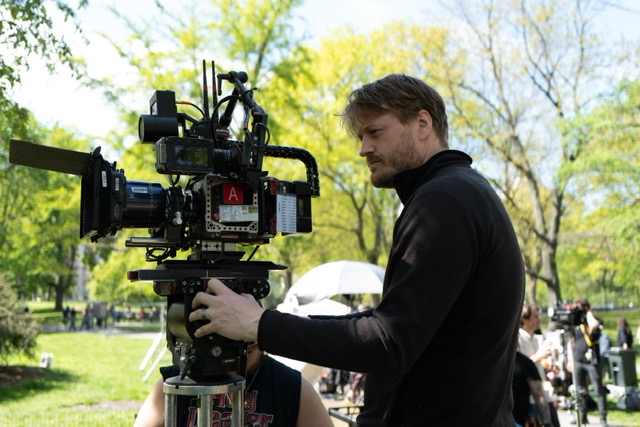
Behind the scenes of “You Hurt My Feelings”
Jeong Park
Dir: Nicole Holofcener, DoP: Jeffrey Waldron
Format: 3.2K ProRes4444HQ
Camera: Arri Alexa Mini
Lens: Panavision Primos
Waldron: New York City is beautiful in the spring time, but Nicole didn’t want the “movie” version of New York — she wanted the lived-in feel of real neighborhoods and real apartments. I worked to build a natural, inviting New York look that didn’t distract from the unfolding story, but brought cinematic punctuation to its important human moments. Panavision New York very generously helped me put together an Alexa Mini package with custom-adjusted Primo lenses. I love the original Primos; they are modern enough, but more nuanced and gentle feeling than many newer, sharper primes. We further accentuated this by further softening them and reducing contrast in prep, and paired with the film emulation LUT that colorist Nat Jencks and I tweaked together, helped the film feel filmic, human, handmade.
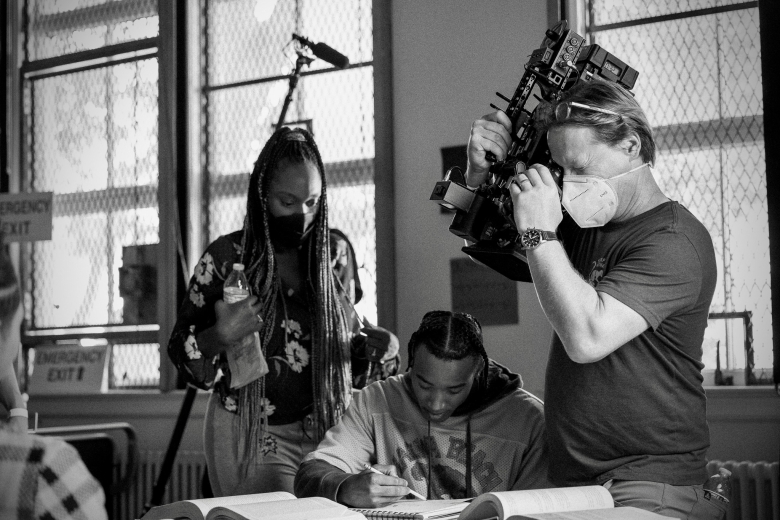
Behind the scenes of “Young. Wild. Free.”
Cary Lalonde
Dir: Thembi Banks, DoP: Cary Lalonde
Format: 4K Arriraw
Camera: Arri Alexa Mini LF
Lens: Panaspeed PV70
Lalonde: When Thembi and I first discussed “Young. Wild. Free.,” and built a visual language for the film, the goal was to give it a look and texture that played to the layers of intensity of the story. As our lead character Brandon, played by Algee Smith, struggles to keep himself and his family together, everything seems to be spiraling out of control. Thembi and I used visual cues through lens choices, camera movement, and lighting to subtly peel back the layers of Brandon’s journey. We chose to load a film emulsion LUT to our Mini LF to maintain our look in dailies, as well as to keep our exposure level consistent for the DI. We shot to maintain as much information and integrity of the image as we could, which left us with beautiful skin tones and rich color, all of which made the DI at CO3 very seamless.
The Mini LF 4.5K in Arriraw met the distribution requirements while giving us a versatile package. As all of our shooting was on location, we were always fitting the camera into small places: a locker, a fridge, or jammed into a car. With the clock always ticking, the Mini LF allowed my 1st AC, Trigg Ferrano, to convert quickly from handheld to studio to crane and Steadicam as the shot demanded.
We paired the camera with the Panavision Panaspeed PV70s that gave our film the look and texture we wanted. The lenses have such a natural fall off in both the highlights and low lights that we chose not to use any diffusion other than a live grain we added in the DI, giving this film an emotional richness in the imagery.
Films appear in alphabetical order by title.
“The Accidental Getaway Driver”

Behind the scenes of “The Accidental Getaway Driver”
Courtesy of Filmmaker
Dir: Sing J. Lee, DoP: Michael Cambio Fernandez
Format: 3.2K Arriraw
Camera: Arri Alexa Mini
Lens: Hawk Anamorphic
Fernandez: I think the wide aspect ratio helped tell the story of four characters in small spaces and emphasize the feelings of being trapped. The Mini helped us get into limited spaces and using one camera allowed the characters to move with what limited spaces we had. The story is about three escaped convicts and one taxi driver held hostage, so the feeling of being limited needed to come across. We wanted to the audience to feel trapped in with our hostage.
“All Dirt Roads Taste of Salt”
Dir: Raven Jackson, DoP: Jomo Fray
Format: 35mm
Camera: Arri Arricam LT
Lens: Arri Master Primes
Fray: We wanted to create an image that was deeply tactile and elemental in its design. Before I even read the script the director, Raven Jackson, told me she was dreaming of this film in 35mm. In a way, shooting on film for us embodied a holistic approach to the work. It gave us the tactile feel and texture we were looking for, but also forced us to have a certain level of intention with each image we created. We crafted an artistic manifesto for the film that we read at the start of each day together. We wanted the light and camera to feel naturalistic and paired down to its most elemental component parts — and we wanted our tools to reflect those values. Shooting on the Arricam LT with the Master Primes gave us the ability to be nimble and quickly adapt to changing conditions. I love the way the Master Primes render on film. They have a soft naturalism that immediately drew us both in.

Behind the scenes of “All Dirt Roads Taste of Salt”
Courtesy of Filmmaker
“birth/rebirth”

Behind the scenes of “birth/rebirth”
Tricia Mears
Dir: Laura Moss, DoP: Chananun Chotrungroj
Format: 3.4K ProRes 4444XQ anamorphic
Camera: Arri Alexa Mini
Lens: Panavision Primo Anamorphic primes
Chotrungroj: Given how tight our locations were, the compact size of the Alexa Mini allowed us to have a small footprint and film in a flexible way. The Anamorphic Primo lenses from Panavision helped craft the visual language of our film — the wide framing allowed us to layer actors in ways that emphasized tension. We also used the anamorphics’ bokeh and blurs to distort the characters and background, conjuring a subtle ghostly feeling.
One of the feelings the film explores is how dangerous giving birth can be. We wanted to show the real violence women sometimes go through when giving birth. I personally had a traumatic experience when I gave birth to my son. Laura and I talked deeply about the details of that experience together and tried to recreate the feeling through the use of Swing/Shift lenses. The Swing/Shift lenses helped create the perspective of a woman giving birth — that disorienting, out-of-place, vulnerable experience.
“Bravo, Burkina!”

“Bravo, Burkina!”
Walé Oyéjidé
Dir: Walé Oyéjidé, DoP: Jake Saner
Format: AHD
Camera: Arri Alexa Mini
Lens: Cooke S4 Suite
Oyéjidé: This film was produced on two continents, in two very different landscapes. We traveled from the cool-green Italian countryside to a quaint village in Burkina Faso where the blazing sun was ever-present. We needed a camera that would travel lightly (across the ocean) while affording great latitude and dynamic range to capture European castles and small West African interiors. Despite the vastness, and occasional harshness of the differing landscapes required by the narrative, the priority or Jake Saner and I was always to produce a beautiful image. With every frame of this film, the Alexa Mini rendered our protagonists with grace and nobility.
“Earth Mama”

“Earth Mama” director Savannah Leaf (left) and cinematographer Jody Lee Lipes
Gabriel Saravia
Dir: Savanah Leaf, DoP: Jody Lee Lipes
Format: 16mm
Camera: Arri 416
Lens: Arri Master Primes and an Angénieux Optimo 12:1
Lipes: Savanah chose not to sugarcoat the main character’s struggle in the system she was born into, but simultaneously used magical realism to explore themes of Black motherhood in the film. So, ultimately there is a mixture of gritty reality and natural beauty in this story. It’s both social services offices and parking lots, and redwoods and nature. 16mm film helped us achieve the beauty and grittiness we were after. Savanah and I went through the script line by line many times, carefully choosing the coverage and camera movement precisely. In contrast to this rigorous shot-listing, the lighting is very basic, unshaped, and real. So there is an intentional aesthetic mixture in the movie of painstaking craft and a hands-off, unadorned lighting approach that fits the duality of Savanah’s story.
“The Eight Mountains”

Behind the scenes of “The Eight Mountains”
courtesy of the filmmaker
Dir: Felix van Groeningen and Charlotte Vandermeersch, DoP: Ruben Impens
Format: Arriraw LF open gate
Camera: Arri Mini LF
Lens: Zeiss Supreme and Angénieux zoom FF
“Fair Play”

Behind the scenes of “Fair Play”
Courtesy of Filmmaker
Dir: Chloe Domont, DoP: Menno Mans
Format: 4K X-OCN XT anamorphic
Camera: Sony Venice
Lens: Cooke Anamorphic
Mans: We chose Cooke Anamorphics for their classic anamorphic character, while still giving us the flexibility and sharpness of modern glass. Stylistically we wanted the film to have an old-school thriller atmosphere, where the viewer immediately senses that something is off.
“Fancy Dance”

Behind the scenes of “Fancy Dance”
Courtesy of Filmmaker
Dir: Erica Tremblay, DoP: Carolina Costa
Format: Arriraw
Camera: Arri Alexa LF
Lens: Arri Signature Primes
Costa: Our philosophy when shooting “Fancy Dance” was “find beauty and magic in everyday life.” In the same way that we wanted to explore Jax and Roki’s beautiful, yet complicated, relationship, we also didn’t want to escape from the dark world around them. We couldn’t close an eye to the reality of indigenous women the same way the system does.
We knew we wanted the large format for this story — the idea was to have the camera close to these women, feel their presence, put them in the center (metaphorically and literally) and be able to see the world around them. The Signature have a beautiful rendition on skin and faces and that was also important for us, that the cinematography represented well the indigenous people sharing their stories.
“The Fishbowl”

“The Fishbowl”
Sundance Institute
Dir: Glorimar Marrero, DoP: PJ Lopez
Format: 4.5K Arriraw
Camera: Arri Alexa Mini LF
Lens: Zeiss Supreme Radiance
Lopez: During the beginning of prep, specifically when doing the first readings, the director and I realized that we needed to tell the story handheld to achieve a special intimacy with our characters. We chose the Alexa Mini LF for its compactness and good 4.5K resolution. At that moment we had a camera! Then, we needed a lens set that provides texture and keeps us close to our actors without the need to use focus diopters, and that was when we found the Zeiss Supreme Radiance at PJ Gaffers Camera Division. We also did tests with the Leica R but the Radiance gave us the texture we wanted and the natural flares that the story was looking for. To complete our look we used a very natural style of lighting that was not very invasive to achieve a look more towards a documentary style. This is what our movie “The Fishbowl” is about: Camera in hand behind our main character who is in the process of dying, reuniting with herself.
“Fremont”

Behind the scenes of “Fremont”
courtesy of the filmmaker
Dir: Babak Jalali, DoP: Laura Valladao
Format: 2.8K Super 35 ProRes 444
Camera: Arri Alexa Mini
Lens: Cooke Speed Panchros
Valladao: While the aesthetics of San Francisco’s Chinatown and a Northern California suburb like Fremont may be somewhat familiar to many, it was important to Babak and I that in the film we experience these places as Donya does, with curiosity and new perspective. Photographing the film in black-and-white allows the audience to see the world with fresh eyes, leaning in to experience textures, patterns, and light, connecting us with Donya’s unique visceral experience from moment to moment.
From early on, Babak and my conversations about the black-and-white look were inspired by the works of our favorite still photographers. We knew we wanted lenses with just a touch of softness and bloom, while having enough sharpness and contrast to resolve nicely in the black-and-white image. The Cooke Speed Panchros did exactly this. They were versatile enough to perform well in situations with direct sun and large windows as well as create some poetic lens flares when the moment called for them. These lenses can vary from lens set to lens set and I really fell in love with our set from Videofax in San Francisco. The TLS rehouse gave us the magic of vintage glass with the speed and reliability of modern housing, which was essential as we were often switching between sticks and handheld within a setup.
“Girl”

Behind the scenes of “Girl”
Tasha Back
Dir: Adura Onashile, DoP: Tasha Back
Format: Arriraw OG Anamorphic
Camera: Arri Alexa Mini
Lens: Cooke Anamorphics
Back: Adura was keen to find a magical look for the world Grace and Ama exist in but without it looking too unreal. I chose the Cookes because the felt like a good balance. By shooting wide open at times and leaning into the distortion of the edges of the lens I could have a more dreamlike look for certain scenes if required. We also used diopters for a lot of scenes where we wanted to be intimate with Ama and see the world through her eyes.
We used a handheld camera on many scenes to enable me to get close to the actors and be responsive to them. We chose a more solid style in the flat to reflect the calmer, safe environment they perceived their home to be.
Color was a major factor in the look of the film and in the lighting choices. I used RGB sources wherever I could to build color into the scenes. My gaffer Paul Joy and I worked closely with the production designer Soraya Gilanni Viljoen to use practical sources in every set and compliment the color choices she had made. I had many conversations with Soraya about textures, reflective surfaces, and window dressings. These things are such a big part of lighting and the effect light has in a room and the way it falls. In the studio we used a mixture of LED and HMI sources through the windows, bounced and/or diffused using a mixture of muslin and the textiles provided by Soraya.
“Heroic”

Behind the scenes of “Heroic”
courtesy of the filmmaker
Dir: David Zonana, DoP: Carolina Costa
Format: 3.2K
Camera: Arri Alexa Mini
Lens: Zeiss Super Speeds
Costa: This is the second film I shot for David. On the first one, “Workforce,” we really learned how to trust the actors (and natural actors) and created depth within a single frame. For “Heroic,” we expanded that language and added more movement. The camera moves not for spiritual or psychological reasons — it’s much more visceral. So the size and weight of the Alexa Mini really helped us move fast. Because most scenes are single shot masters, the composition had to be extremely thoughtful and precise. We rehearsed each shot many times before doing the take. That also helped since our cast was a mix of trained and natural actors. The speed of our lenses was essential since our lighting package was pretty small.
The way we framed the group shots was always to show the rigidity of this world, but also the toxic masculinity that exists in this group. The location was a character and we also wanted to express the battle between the system versus the man. We shot about 80 percent of the film with wide angles lenses, such as the 16mm and 18mm. The dream sequences are a key element in the narrative and it was a fine balance shooting those, because we didn’t want them to feel like a “fantasy” — they had to feel real and yet strange.
I am very familiar with the Alexa Mini and I feel comfortable shooting in higher ISO and pushing it a bit further. I really love the texture in that world. The exteriors of our location were rich but the interiors were basically bare white walls, so adding that “texture” on camera was super important.
“In My Mother’s Skin”

Behind the scenes of “In My Mother’s Skin”
Richard Visco
Dir: Kenneth Dagatan, DoP: Russell Morton
Format: 3.4K S35 Arriraw, 4.5K LF Arriraw
Camera: Arri Alexa Mini LF
Lens: Cooke Panchro/i, TLS Petzval 58mm, Angénieux Optimo Style 25-250mm T3.5 10x zoom
Morton: “In My Mother’s Skin” is a film set during World War II in the Philippines. I found the film to have a strong Catholic imagination and this provided an opportunity for us to reference religious paintings of the renaissance masters within the lighting and framing choices. The Panchro/i were an obvious choice for me as I felt that the focus roll offs of the Panchros remind me of brush strokes with oil and canvas and these characteristics lent its quality towards a more painterly image. In addition to that, the history of its optical design aligns with the period of the narrative of the film which made conceptual sense to me.
In the film, there is an encounter with a supernatural entity — a fairy. We opted to photograph some of the fairy scenes with a lens that has a strong, unique character that would help these encounters appear more magical and surreal. The TLS Petzval has a swirly bokeh effect in the out-of-focus regions and this gave the image a more dreamlike quality. However, to get the full effect of this lens, you would need to have a larger format sensor and the Panchros that we were using for the main sections of the film were Super 35. To address this, we opted to use the Arri Mini LF and interchange between LF and S35 mode when necessary in order to get the full effect of the Petzval.
“Jamojaya”

Behind the scenes of “Jamojaya”
David Matheny
Dir: Justin Chon, DoP: Ante Cheng
Format: 35mm 3-perf
Camera: Arricam LT, Sony Venice, Panasonic miniDV
Lens: Kowa Cine Prominars, Canon Rangefinder Primes, Canon K-35 zoom
Cheng: Honestly, we just wanted to shoot on 35mm film.
“Landscape with Invisible Hand”

Director Cory Finley, cinematographer Lyle Vincent, and actor Asante Blackk on the set of “Landscape with Invisible Hand”
Lynsey Weatherspoon
Dir: Cory Finley, DoP: Lyle Vincent
Format: 4K Sony RAW 4.3
Camera: Sony Venice
Lens: TLS rehoused Bausch & Lomb Super Baltars
Vincent: We originally wanted to shoot on film because we loved working in the medium on “Bad Education.” We thought the grain and subtle texture of film would help marry our VFX seamlessly and also add a feeling of bygone era to the near future world where aliens have inhabited Earth. When shooting on film didn’t pan out we settled on the Venice with vintage Super Baltars as well as live film grain add to get as close as we could. We also played with the idea of old academy 1.33 aspect ratio but settled on the 16mm film gate and early European version of 35mm of 1.66 ratio. It also threw homage to one of our reference films, “A Clockwork Orange.”
“L’immensitá”

Behind the scenes of “L’immensitá”
Angelo Turetta
Dir: Emanuele Crialese, DoP: Gergely Poharnok
Format: 2.8K Arriraw
Camera: Arri Alexa Mini
Lens: Zeiss Supreme Prime
Poharnok: This is a period film, the story takes place in Rome in the ’70s. For me it was important that the audience experience this drama in the present moment, and watch it as if being there with this family. I felt if we use a visual language that tries to imitate the cinema of the ’70s, or if we over-stylize the images, it would create a distance between the viewer and our characters.
Penélope Cruz plays the mother, and with her wherever you put your light or camera she just looks fantastic. In the film she is a mother who goes through lots of trauma. If we showed her too glamorous, that would have been totally wrong for the story. We liked the imperfection and bit of noise in the standard Alexa Mini image, so we chose not to shoot with a large format sensor. For the lens we tested many vintage and modern glasses. We didn’t like flares or distortion, but preferred lenses that had a clean but soft character. Supreme turned out to be the right choice for this film. The Alexa Mini and the Supremes helped us to tell this very intimate and personal story in the right way.
“A Little Prayer”

Behind the scenes of “A Little Prayer”
Joshua Campell
Dir: Angus MacLachlan, DoP: Scott Miller
Format: 4.5K ProRes 4444HQ 3:2 open gate
Camera: Arri Alexa Mini LF
Lens: Canon K35 primes 24mm, 35mm, 45mm, 55mm, 85mm
Miller: “A Little Prayer” reveals the complex dynamics centered around a family in the South, as our characters unexpectedly find ways to connect with each other, and maintain the bonds of love.
Part of the approach for “A Little Prayer” was to give space on the set to the actors and the director, lighting when possible with large bounce sources outside, accentuated with a small mirror or two to create hot spots of light. The lensing approach went hand in hand, keeping the photography simple, finding the right place for the camera, and maintaining a wider frame. We sought to create a portrait of a multigenerational family. While the characters in the story navigate challenges and darker emotions, the camera and the lighting were to accentuate the warmth and love still between the family.
I was very fortunate to begin a Zoom dialogue with the director about six months before the shoot. It was precious time, as we would have a short prep on the ground. Angus brought in references including The Hudson River School painters, the photography of Henri Cartier-Bresson, and the cinematography of Néstor Almendros. We explored the quality of light and color from these artists’ work.
“A Little Prayer” was filmed entirely on location in Winston-Salem, NC, and the compact size of the Mini LF allowed us keep a small footprint. Paired with the Canon K35s, this lent a softness and naturalism to the image. As the shoot progressed, we began to rely on the 45mm focal length. I often find there is a lens that becomes the hero lens on a shoot, and for us it was the 45mm. We decided to use the larger format and embrace an aspect ratio of 1.59. For me, this contributed to a feeling of bearing witness to a home and family, akin to that of a photograph or canvas.
“Mamacruz”

Behind the scenes of “Mamacruz”
Courtesy of Filmmaker
Dir: Patricia Ortega, DoP: Fran Fernández-Pardo
Format: Arriraw
Camera: Arri Alexa Mini LF
Lens: Cooke S7
Fernández-Pardo: We recorded on Alexa Mini LF. I always trigger on Alexa. When I try another camera, I always regret my decision and want to go back to Alexa. The lenses we used were Cooke S7. I was looking for a soft lens to create contrast with the lighting. The idea was to visually accompany the changes of the protagonist. The story evolves from winter settings to summer settings. The diffused, soft, and cold light of winter represents the monotony of Cruz’s life. In winter the sun is closer to the horizon throughout the day, so it is difficult for him to enter a small house in a neighborhood with narrow streets. When there are no shadows, there are no doubts. Everything is seen, everything is known, everything is monotonous. Cruz changes and the environment gains warmth, contrast, direct light, and shadows. We are approaching summer. The shadows represent what we do not see, what can be discovered. The same thing that Cruz is doing with his life.
“Mami Wata”

Behind the scenes of “Mami Wata”
courtesy of the filmmaker
Dir: C.J.Obasi, DoP: Lílis Soares
Format: Arriraw
Camera: Arri Alexa Mini
Lens: Zeiss CP3 and Angénieux zoom
Soares: “Mami Wata” is an aesthetically daring film. The choice of director C.J. Obasi to make a film in black-and-white with 99 percent of actors with jet black skin, shot essentially at night, either on the beach or in the forest, and with an ancestral African theme would be a great challenge. However, in a short time, we understood that the pandemic and structural issues would make our process even more difficult. Many adaptations were necessary in my initial planning. The equipment was coming from Nigeria to Benin, the country where we recorded, and we had a very long delay in delivery, which also brought difficulties in terms of the filming plan. I think what defines this project is the creativity to find technical and narrative solutions for the scenes.
A filmic process like this says a lot about what it will become and which pieces are in fact fundamental for sustaining an aesthetic unity. As a cinematographer, I had in my hands an incredible opportunity to visit my roots and explore Black and diasporic aesthetic codes in depth. My personal and professional research object is precisely the search for insertion of codes and messages in image creation. Understanding what new gaze really is, and how my trajectory and technique can influence narratively and creatively the production of images. Alexa is my favorite camera and together with the quality of the Zeiss lenses and Angénieux zoom lenses I was able to get interesting results many times in terms of texture, depth of field and movements. The Black skin, the texture of the sea, the contrasts and the brightness of the night were important elements in this experiment and, as an essay, we could see in images that there is a Black African narrative aesthetic, a story that plays with the senses, with the occult, which still needs to be looked at with more responsibility and sensitivity.
“Mutt”

Behind the scenes of “Mutt”
courtesy of the filmmaker
Dir: Vuk Lungulov-Klotz, DoP: Matthew Pothier
Format: Arri 4:3 open gate
Camera: Arri Alexa Mini
Lens: Leica Noctilux 50mm .95 and Summicron
Pothier: We shot probably 80-plus percent of the movie on the 50mm Leica Noctilux which is a really fast T.95 lens. We wanted the movie to feel like a series of medium format photographs, but also to capture the energy of the city. Keeping the camera package simple and realistic to our constraints gave us the most flexibility to adapt to the chaos that is shooting a micro budget movie in stolen and borrowed locations deep in the heart of Bushwick, Brooklyn. But also from a practical standpoint we had a tiny, and sometimes nonexistent, lighting team so having a lens that would shoot in the darkest of conditions proved to be invaluable. Huge shoutout and thanks to our tiny but mighty G/E, camera, art, and production teams.
“Onyx the Fortuitous and the Talisman of Souls”

Behind the scenes of “Onyx the Fortuitous and the Talisman of Souls”
Justin Allen
Dir: Andrew Bowser, DoP: Dan Adlerstein
Format: 2.8K ProRes4444XQ 4:3 2x squeeze
Camera: Arri Alexa Mini
Lens: Atlas Orion Anamorphics
Adlerstein: There was a fine balance to strike in shooting a character-based throwback horror-comedy meant to be fun, spooky, and emotional all at once. And one of the first decisions director Andrew Bowser and I made about the look and feel of “Onyx” was for it to be shot anamorphic. Yes, we wanted that grand and epic feel that anamorphic can help provide. But also: “Onyx” is an ensemble piece, and the 2.39 aspect ratio would allow for more natural framing of group shots. We wanted to get creative with negative space. We wanted the shallow depth of field to give a sense of mystery to the surroundings. And knowing we’d have many candles in the background of shots, we thought the anamorphic bokeh would help reinforce the gothic mood and atmosphere of the location. What surprised me on set was how much I wound up reaching for the wider focal lengths for close-ups and mediums. I can’t say that was the original plan, but especially with the main character of Onyx himself, we found ourselves loving the feel of the 40mm and even 32mm just a few feet away. Not only did it feel intimate by bringing the viewer into Onyx’s subjective experience, but we found these shots to be fun and dynamic as well — a big part of that balance we were striving for.
“Passages”

“Passages”
Courtesy Sundance Institute
Dir: Ira Sachs, DoP: Josee Deshaies
Format: 3.2K
Camera: Arri Alexa Mini
Lens: Cooke S4
Deshaies: When not shooting on film, I love the Alexa. It’s like an old friend (you excuse the faults and really appreciate the qualities). The film was shot on a very small budget and on a short schedule. I wanted to experiment not with the equipment but more with the director’s mise en scène, the acting, and the length of some shots. The film is about intimacy, the power of humans over other humans, the beginning and the end of things (passages). I didn’t want the technique to get in our way of telling the story but to be a gentle companion.
“Past Lives”

Shooting “Past Lives”
John Pack
Dir: Celine Song, DoP: Shabier Kirchner
Format: 35mm 3-perf
Camera: Panavision XL2
Lens: P vintage, Panavision Ultra speed’s, Primo Zooms
Kirchner: During the early stages of pre-production Celine and I discussed the conceptual ideas behind “Time” and “Love” and how to best bring those qualities to the image in harmony with the script. 35mm film naturally became a deep part of our conversations and eventually our philosophy when developing the visual language of the film. We push-processed the entire picture by at least +1 stop and in some cases pull processed -2 stops in order achieve the desired feeling in the contrast, grain, and overall softness. Panavision worked with us on putting together the perfect set of lenses needed to frame the characters’ faces as our landscapes.
“The Persian Version”

Behind the scenes of “The Persian Version”
Yiğit Eken
Dir: Maryam Keshavarz, DoP: André Jäger
Format: 3.4K Arriraw
Camera: Arri Alexa Mini
Lens: Cooke S7i
Jäger: I knew from a very early stage that the Mini would be the perfect tool for us since we would be shooting mostly handheld and Steadicam on location, in a wide range of environments under all kind of weather conditions. Choosing the perfect lens was the bigger challenge. Since our story takes place in different decades, I considered shooting anamorphic because of the timeless look they deliver. Moreover, one of the things Maryam repeated throughout the whole production was that we should embrace the imperfection. So it made even more sense to me to go for anamorphic lenses because of characteristics like their susceptibility to flares. But after testing a variety of lenses (spherical and anamorphic) on different cameras we felt that anamorphic wouldn’t be the right choice for our needs.
We needed a more versatile set of lenses to be able to shoot in small spaces and without worrying constantly about close focus. After discussing the test results with Maryam, the Cooke S7 with their natural look, the soft rolling off focus in combination with the Alexa Mini was what excited us the most. In particular, the way the Cooke S7 capture different kinds of skin tones and their natural rendering convinced us. Of course choosing the S7 was a bit contrary to my original plan of having a small and lightweight camera build. So we took a set of Cooke S4 along with us. They match perfectly with the S7 and I used them for smaller camera builds whenever needed.
“The Pod Generation”

Cinematographer Andrij Parekh and director Sophie Barthes on “The Pod Generation”
Isabel Palomar
Dir: Sophie Barthes, DoP: Andrij Parekh
Format: 4.5K Arriraw
Camera: Arri Alexa Mini LF
Lens: Tribe 7 Blackwing primes
Parekh: Creating the look for “The Pod Generation” proved to be an interesting challenge. As the film is “near-fi sci-fi,” and the main theme of the film is birth and re-connecting to nature, we wanted to avoid the traditional sci-fi genre tropes and instead wanted the created world to feel softer, rounder, more pastel, more feminine, and so we chose colors and a palette and design that would lean into that approach. Compositions in the city tended toward more formal, and once the film ventures into nature, the style became much looser. I use available light as much as possible, and this also lent a more organic feel to the process of filmmaking. And as the budget was incredibly tight and we were relying on little artificial lighting, the Alexa LF and the fast Blackwing primes were an excellent choice to realize Sophie’s vision.
“Polite Society”

Director Nida Manzoor, cinematographer Ashley Connor and actor Priya Kansara on the set of their film “Polite Society”
Saima Khalid
Dir: Nida Manzoor, DoP: Ashley Connor
Format: 2.8K ProRes4444 4:3
Camera: Arri Alexa Mini
Lens: Cooke Anamorphic
Connor: Nida and I chose to go anamorphic because it felt in line with the genre we were playing within. We wanted Ria’s world to be big and colorful which was heavily achieved through the production and costume design, beautifully done by Simon Walker and PC Williams. We wanted the action to play loud yet be grounded in an idiosyncratic style. The Cookes ended up yielding a certain level of intimacy while not attributing too many anamorphic characteristics to the image.
“Radical”

Behind the scenes of “Radical”
courtesy of the filmmaker
Dir: Christopher Zalla, DoP: Mateo Londono
Format: We captured in 4.5K Arriraw open gate, framing for 2.39:1 aspect ratio
Camera: The cameras we used were Arri Alexa Mini LF, mostly using two cameras and sometimes even three in the classroom scenes with lots of kids
Lens: For lenses we used a combination of rehoused Canon K-35 with Canon EF primes and occasionally a Zeiss Compact Zoom 70-200mm. These lenses let us take advantage of the large format sensor of the Mini LF.
Londono: We used the Canon K-35 and EF lenses for their softer and non-clinical feel. These lenses were manufactured in Japan in the 1970s and ’80s, many of them by hand, and therefore lack the “perfection” of modern lenses. Christopher Zalla and I wanted to lean into these “imperfections” to achieve a look that felt less controlled without making it gritty. This was our approach for framing and lighting as well. Sometimes going as far as framing out people’s heads or characters all together. Sometimes we would intentionally break the line during coverage to cause a sense of confusion. We favored what could be considered as “mistakes” in classic filmmaking. Our story takes place in a Mexican boarder town plagued with neglect, corruption, and violence. The main character in the film, Sergio, is a teacher (played by Eugenio Derbez), who is trying a method to break through to his students’ apathy and unlock their potential. This path is in no way a straightforward one where there are some successes and some failures. We felt that approaching the cinematography in this way would support his and his students’ journey.
“Rye Lane”

Behind the scenes of “Rye Lane”
Chris Harris/Courtesy of Searchlight
Dir: Raine Allen-Miller, DoP: Olan Collardy
Format: 2.8K Arriraw
Camera: Arri Alexa Mini
Lens: JDC Xtal Xpress Anamorphic Lens
Collardy: For “Rye Lane,” I chose to shoot with the Arri Alexa Mini, as I have found it to be one of the best digital cameras on the market in terms of color rendition and skin-tone reproduction. These two factors were of paramount importance to me, given the nature of the world and the characters we were capturing on film.
In my conversations with Raine, we agreed on pushing the boundaries of the genre, striving for something that was edgier, distinct, and visually striking. We wanted to create a film that stood out for its unique identity and visual language, all the while staying true to life and relatable to audiences. In order to achieve this, we decided that anamorphic format would be the best approach as it allowed us to create an image that was grand in scope, while still capturing the complexities of human experience that was at the heart of the subject matter.
After extensive experimentation with various lenses, I found that the JDC Xtal Xpress High Speed Anamorphic lens set was the perfect tool for our visual storytelling. These lenses, with their vintage character and charm, provided us with a distinct and beautiful aesthetic that elevated the film’s visual language. The 24mm focal length quickly became our go-to for its ability to transform every frame into a vibrant and striking image, capturing the unique distortions that were perfect for the style and story of the film. The lenses were an integral part of our visual language, bringing the film’s atmosphere and characters to life in a way that was both captivating and memorable.
“Scrapper”

“Scrapper”
Chris Harris/Sundance Institute
Dir: Charlotte Regan, DoP: Molly Manning Walker
Format: ProRes
Camera: Arri Alexa Mini
Lens: Meru anamorphics
Bareiša: “Scrapper” is the story of a young quirky girl who runs her own life after her mother dies suddenly. The story is told from the kid’s perspective. We really wanted to heighten the world. We wanted to really encapsulate the amazing brain of young kids. Everything we did was to add a magical element to the storytelling. Our aim was to avoid the classical British estate drama which is often portrayed in a gritty gray and “real way.” The Merus add a soft magical element to the world and took it a step away from reality.
“Shayda”

Shooting “Shayda”
Jane Zhang
Dir: Noora Niasari, DoP: Sherwin Akbarzadeh
Format: ProRes 4444XQ
Camera: Arri Alexa Mini
Lens: Panavision Primo
Akbarzadeh: We wanted to shoot on film but never really entertained it because we knew we’d be working with a child actor and doing long, unstructured takes. So I shot on the Alexa Mini, which has been my go-to for many years. I opted for a Super35 sensor over the LF because it feels like a more natural perspective to me and I wanted the camera to feel unobtrusive. We also wanted it to feel a bit like celluloid without relying on film grain in the DI. Shooting the Alexa at 1600 ISO gives the image a filmic quality not only in the embedded noise structure but in the tonal curve which favors information in the highlights rather than the shadows. We used Panavision Primo lenses which have a nice sharpness to them without betraying our 90s period feel.
“Shortcomings”

Behind the scenes of “Shortcomings”
Jon Pack
Dir: Randall Park, DoP: Santiago Gonzalez
Format: 3.8k ProRes 4444 LogC
Camera: Arri Alexa Mini LF
Lens: TLS rehoused Canon Rangefinders and Hawk V-lite Anamorphics
Gonzalez: After testing numerous lenses, Randall and I ultimately decided to pair the Mini LF with Canon Rangefinders. I loved how this combination rendered natural-looking skin tones and softened highlights, creating a subtle bloom — and the focus fall-off from center frame. While we went for a stylized look, we still wanted to preserve a natural and authentic feeling, and the Rangefinders did just that. Furthermore, we collaborated with our amazing colorist, Billy Hobson from Harbor Picture Company, to differentiate the cities’ visuals in the film. Billy helped us design different LUTs to convey a cooler atmosphere in the Bay Area versus a warmer one in NYC. Additionally, in one section of the film, we shot anamorphic, pushing the stylization closer to fantasy.
“Slow”

Shooting “Slow”
Andrius Aleksandravičius
Dir: Marija Kavtaradze, DoP: Laurynas Bareiša
Format: 16mm
Camera: Aaton XTR S16
Lens: Zeiss Ultra 16
Bareiša: We shot on the Aaton XTR S16. The film was shot entirely handheld and Aaton is really comfortable to use in this configuration. The lenses were Arri Zeiss Ultra 16 and these were pretty much the only ones available for 16mm at that time here.
“Sorcery”

Behind the scenes of “Sorcery”
Maria Secco
Dir: Christopher Murray, DoP: Maria Secco
Format: 3.8K Arriraw
Camera: Arri Alexa Mini
Lens: Cooke S7
Secco: What most drew me to the movie, apart from the script which I loved, was the anthropological investigation Christopher had been working on in the island where the past events and the present would be related. Also, the idea of shooting on such a remote island, in winter, with very rare climate and light situations was very appealing.
The shooting was only four and a half weeks long, with multiple challenges. For that reason, we decided to work with Trinity operator Mirko Zlatar, almost all the time — even in some wonderful scenes completely under the rain which was a constant — so the Alexa Mini was a very good choice. Also the anamorphic format was something Christopher and I both wanted to explore in the island landscapes and with the characters close-ups, and the Cooke S7 contrast and color was a good choice. Though we didn’t have the opportunity to take the 65mm close focus, which I missed it quite a lot. The light equipment was very little, and we lit a lot of the night scenes and interiors with real fire to be used behind the camera and as props, maximized with light stream reflectors.
“The Starling Girl”

Behind the scenes of “The Starling Girl”
Dir: Laurel Parmet, DoP: Brian Lannin
Format: ARRIRAW 4.5K LF 3:2 OpenGate (1:85 crop)
Camera: Arri Alexa Mini LF
Lens: Zeiss Supreme Primes
Lannin: The choice of camera and lenses were both practical and creative. I wanted something small, fast, and beautiful and the Alexa Mini LF and Supreme Primes gave us all of that. I also happened to own the camera and lenses, so it afforded a lot of flexibility to the production and helped us put our limited resources into other things.
This film is rooted in Jem Starling’s POV (our main character, played by the incredible Eliza Scanlen). She’s in every scene and we are experiencing things with her, in the moment. I wanted the photography to be very present, intimate, somewhat reactionary, and subjective, without being too dogmatic in terms of its subjectivity. The camera needed to always be moving with her, able to hold close focus, in small practical locations, often on my shoulder, so a compact system with spherical lenses was crucial. The entire package had to be nimble and manageable for our small crew as well. It was a very simple camera package, just a single box of lenses!
We also wanted the movie to have a strong timeless print film look, that could capture the raw emotion of Eliza Scanlen’s face in a way that was beautiful, without being polished, and enhance the lush landscapes and textures of rural Kentucky, where the film is set. We developed our look prior to shooting with Sean Coleman, our colorist. I knew that the Alexa was the right sensor to deliver what we were after as I have been working with it for many years.
“Talk to Me”

Behind the scenes of “Talk to Me”
Mathew Thorne
Dir: Danny Philippou and Michael Philippou, DoP: Aaron Mclisky
Format: 4.5K Arriraw
Camera: Arri Alexa Mini LF
Lens: Zeiss Supreme Primes
Mclisky: Since “Talk to Me” is a contemporary suburban teen horror set mainly at night, I jumped at the chance to pair the Alexa Mini LF with a set of Zeiss Supreme Primes. I needed a package that would give me the ability to lift the shadows in moments with a fast stop. The boys like to work fast — go ‘RACKA’ as we would say — this meant having a camera and lens package that I could be flexible with whilst maintaining a look we were all happy with. We wanted a modern look, nothing too fruity and nothing to clean. Pairing the Supremes with 1/4 Glimmer Glass was our go to for subtly lifting blacks and blooming the highlights.
“Theater Camp”

Behind the scenes of “Theater Camp”
Jeong Park
Dir: Molly Gordan and Nick Lieberman, DoP: Nate Hurtsellers
Format: Alexa S16HD
Camera: Arri Alexa Mini
Lens: Canon s16 8-64mm, Canon s16 6.6-66mm, Canon s16 11-165mm
Hurtsellers: For the mockumentary “Theater Camp,” we took visual inspiration from the roughly fashioned camera work of many iconic documentaries (“Jesus Camp,” “The War Room,” “Grey Gardens”). We wanted to undercut the absurdity and comedy with imprecise, “caught” visuals — naturalistic lighting, observational lensing, and a general sense of the camera trying to keep up with the action.
Improvisation was a big part of the comedy, so almost everything was cross-shot and handheld. Having a lightweight, flexible setup was critical. Embracing the s16HD format really became critical to the look. The Canon s16 zooms are fast, light, and have significant focal range. The deeper stop and somewhat degraded images helped push us towards a lo-fi, 16mm-ish look.
As the characters in the film become more and more comfortable with our fictionalized documentary crew, we allowed ourselves to get closer and closer to the eye lines and the action. There’s a lot of heart in the film. It was important that we not stay far away for too long. I loved the 8mm two feet away from a face. It could be both hilarious and intimate.
“A Thousand and One”

“A Thousand and One”
courtesy of Focus Features
Dir: A.V. Rockwell, DoP: Eric K. Yue
Format: 3.2K
Camera: Arri Alexa Mini
Lens: Panavision Super Speeds and Panavision Primos
Yue: We shot the film with two sets of lenses: Panavision Super Speeds and Panavision Primos. The ’90s section was shot with the vintage Super Speeds wide open with a 1/8 Black Pro Mist, for a softer and grainier image. The 2000s section was photographed with Primos without filtration at T2.8 or higher which produces a cooler, sharper, and crisper image. Their world becomes colder and darker as the two become distant from each other and their surroundings over the years. I wanted to use vintage and modern lenses to subtly suggest an emotion and temporal shift in the visual language.
“When It Melts”

Behind the scenes of “When It Melts”
Thomas Sweertvaegher
Dir: Veerle Baetens, DoP: Frederic Van Zandycke
Format: 2.8K ProRess 444 anamorphic
Camera: Arri Alexa Mini LF
Lens: Cooke Anamorphics 1.8x FF SF (50mm, 75 mm, 100 mm, 135mm)
Van Zandycke: I’ve worked with these lenses before so I knew exactly what they would bring to the table. My first idea was to go for the 16:9 ratio with some old lenses to give a certain reality to it but then I felt I wanted to add just that little bit more distance with what your eye perceives. They also maintain sharpness with our blooming away. These lenses are anamorphic but don’t over-exaggerate this look. It just gives the bokeh that little subtle touch that I love. In the past storyline in this film most of the scenes were shot on the 50 and 75 mm with 1/4 glimmer in the matte box. The journey starts wide and open and it slowly creeps closer and rules out establishing since we didn’t feel the need for it. The present storyline was mostly shot on 100 and 135mm.
“You Hurt My Feelings”

Behind the scenes of “You Hurt My Feelings”
Jeong Park
Dir: Nicole Holofcener, DoP: Jeffrey Waldron
Format: 3.2K ProRes4444HQ
Camera: Arri Alexa Mini
Lens: Panavision Primos
Waldron: New York City is beautiful in the spring time, but Nicole didn’t want the “movie” version of New York — she wanted the lived-in feel of real neighborhoods and real apartments. I worked to build a natural, inviting New York look that didn’t distract from the unfolding story, but brought cinematic punctuation to its important human moments. Panavision New York very generously helped me put together an Alexa Mini package with custom-adjusted Primo lenses. I love the original Primos; they are modern enough, but more nuanced and gentle feeling than many newer, sharper primes. We further accentuated this by further softening them and reducing contrast in prep, and paired with the film emulation LUT that colorist Nat Jencks and I tweaked together, helped the film feel filmic, human, handmade.
“Young. Wild. Free.”

Behind the scenes of “Young. Wild. Free.”
Cary Lalonde
Dir: Thembi Banks, DoP: Cary Lalonde
Format: 4K Arriraw
Camera: Arri Alexa Mini LF
Lens: Panaspeed PV70
Lalonde: When Thembi and I first discussed “Young. Wild. Free.,” and built a visual language for the film, the goal was to give it a look and texture that played to the layers of intensity of the story. As our lead character Brandon, played by Algee Smith, struggles to keep himself and his family together, everything seems to be spiraling out of control. Thembi and I used visual cues through lens choices, camera movement, and lighting to subtly peel back the layers of Brandon’s journey. We chose to load a film emulsion LUT to our Mini LF to maintain our look in dailies, as well as to keep our exposure level consistent for the DI. We shot to maintain as much information and integrity of the image as we could, which left us with beautiful skin tones and rich color, all of which made the DI at CO3 very seamless.
The Mini LF 4.5K in Arriraw met the distribution requirements while giving us a versatile package. As all of our shooting was on location, we were always fitting the camera into small places: a locker, a fridge, or jammed into a car. With the clock always ticking, the Mini LF allowed my 1st AC, Trigg Ferrano, to convert quickly from handheld to studio to crane and Steadicam as the shot demanded.
We paired the camera with the Panavision Panaspeed PV70s that gave our film the look and texture we wanted. The lenses have such a natural fall off in both the highlights and low lights that we chose not to use any diffusion other than a live grain we added in the DI, giving this film an emotional richness in the imagery.

